
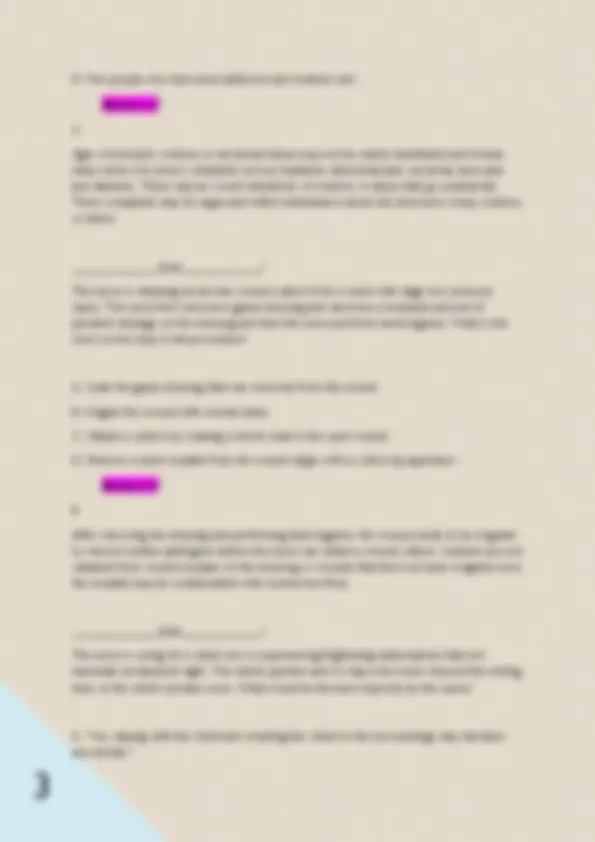
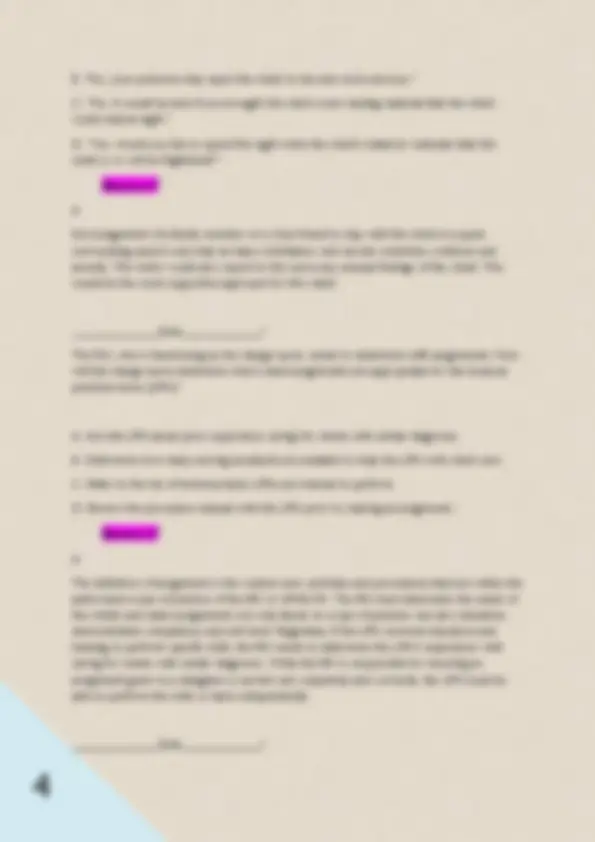
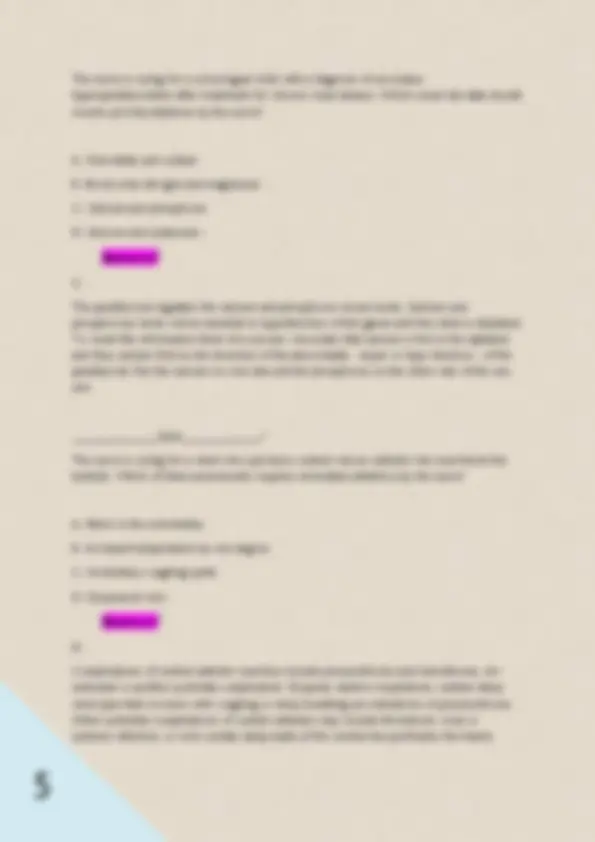
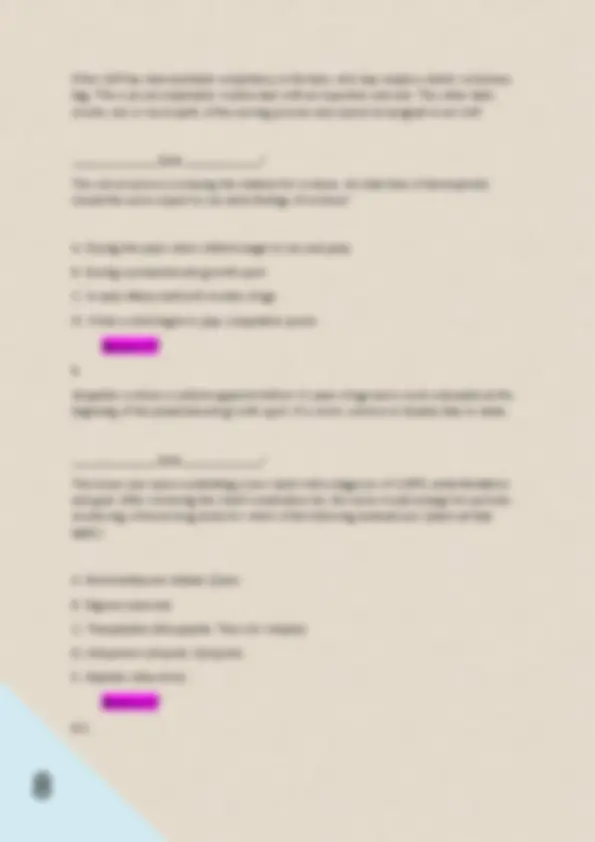
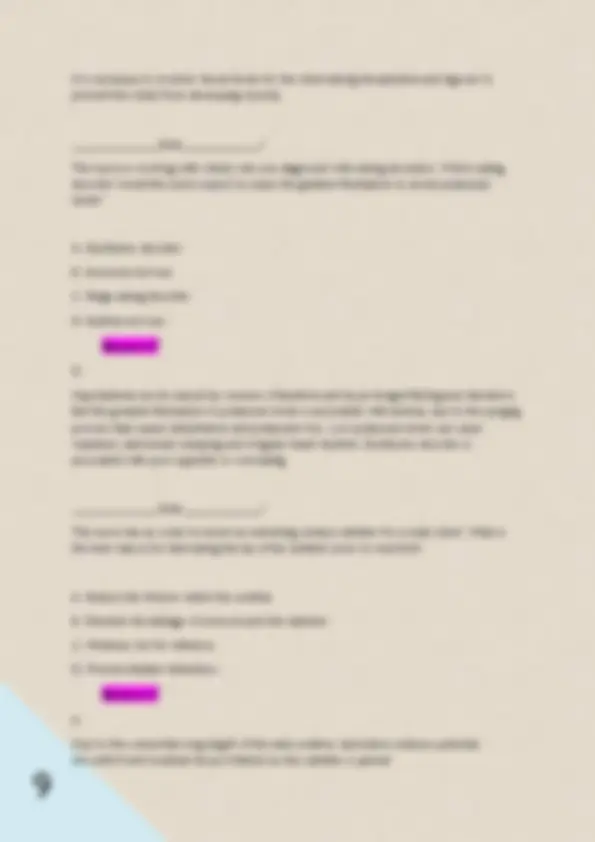
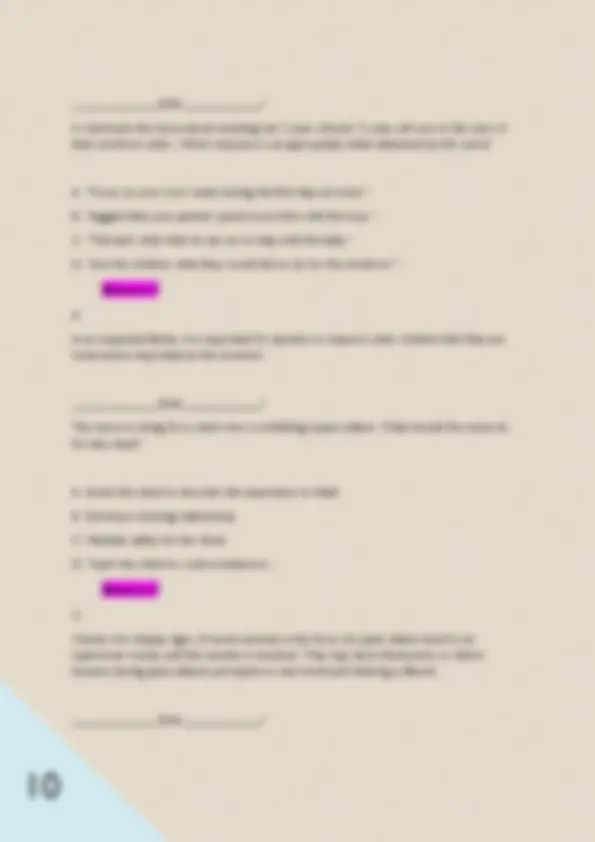
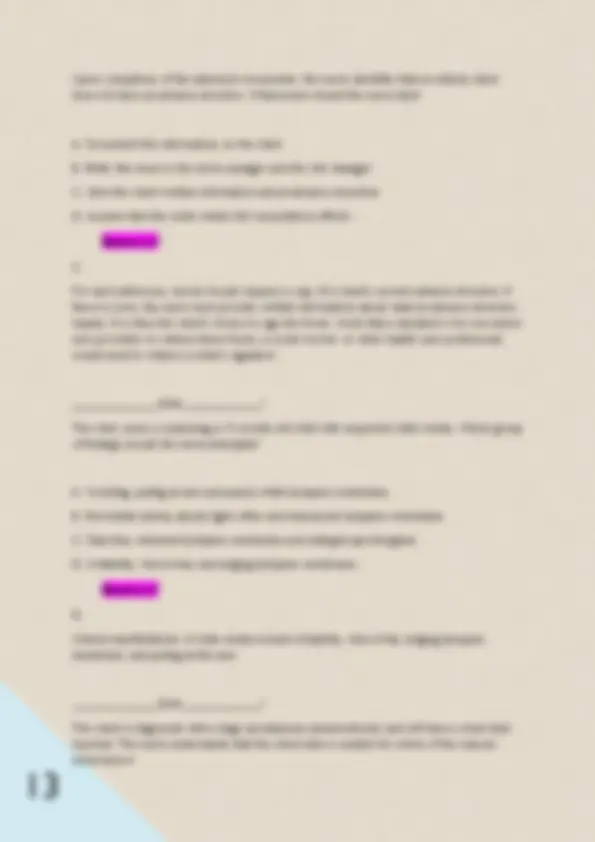
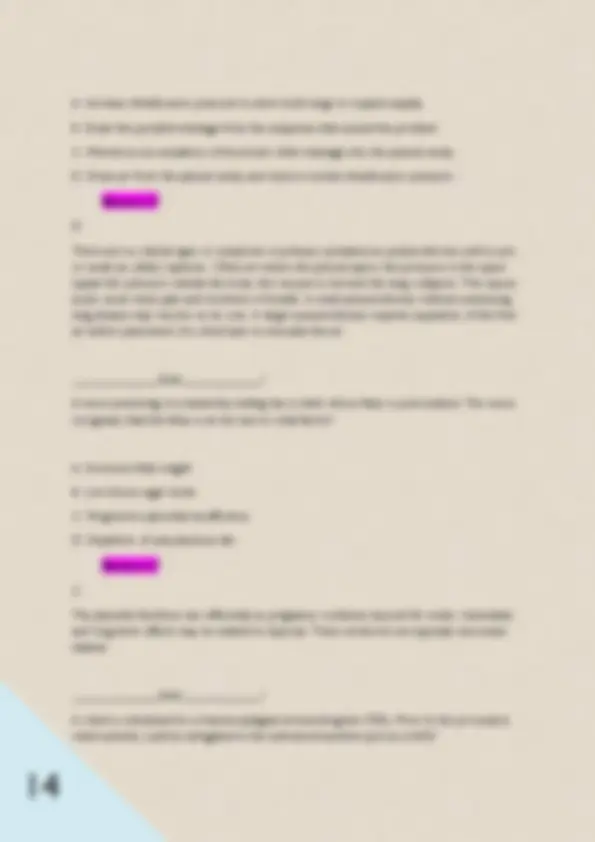

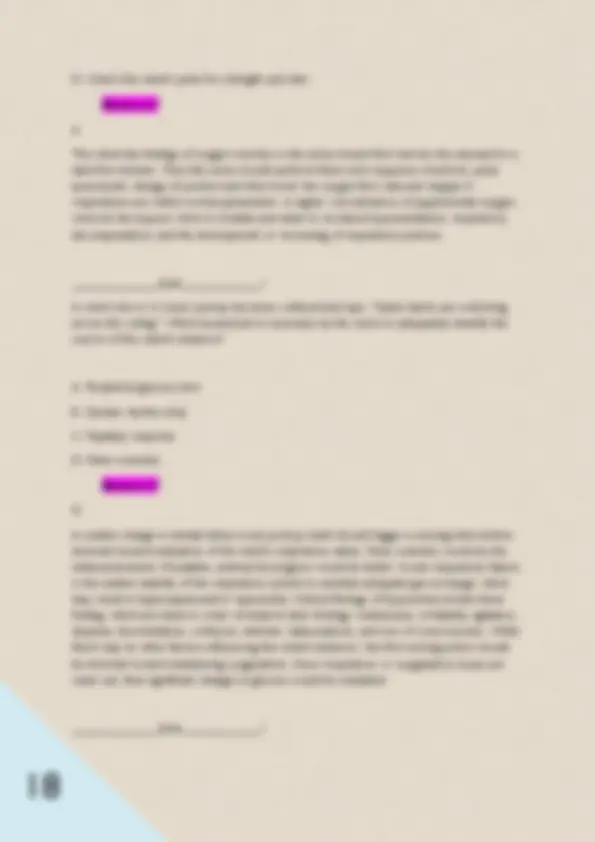
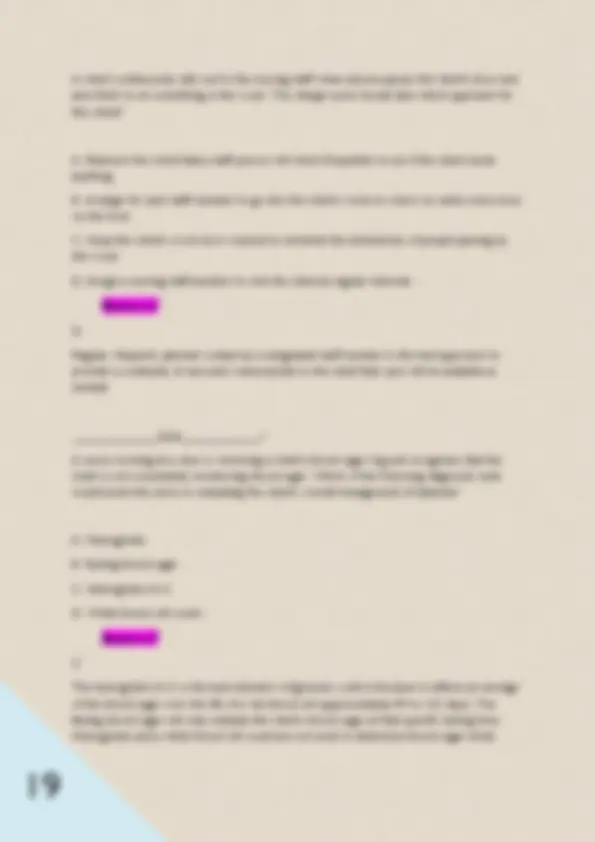
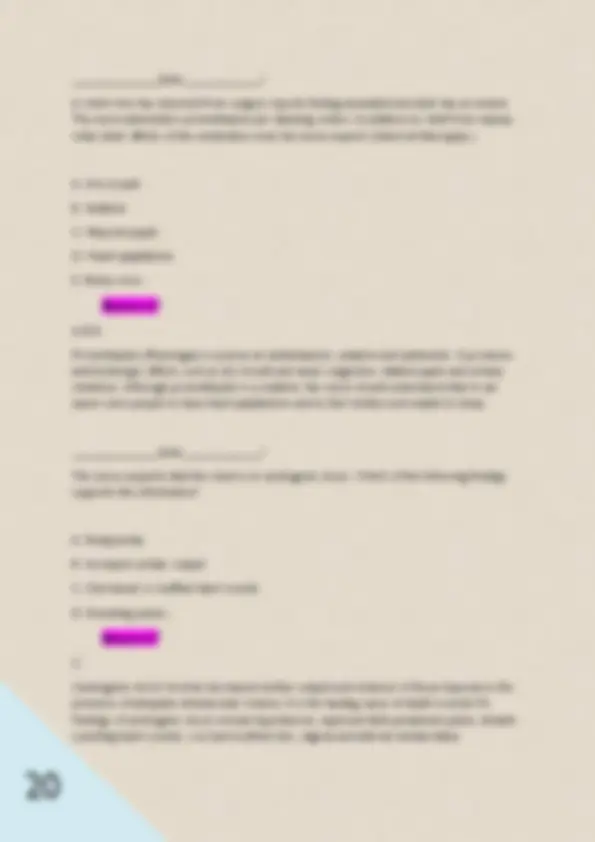
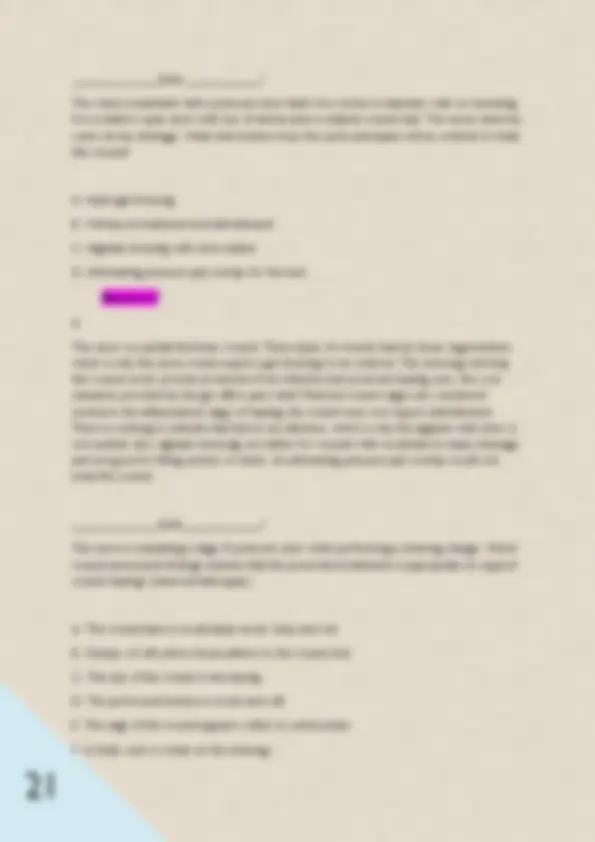
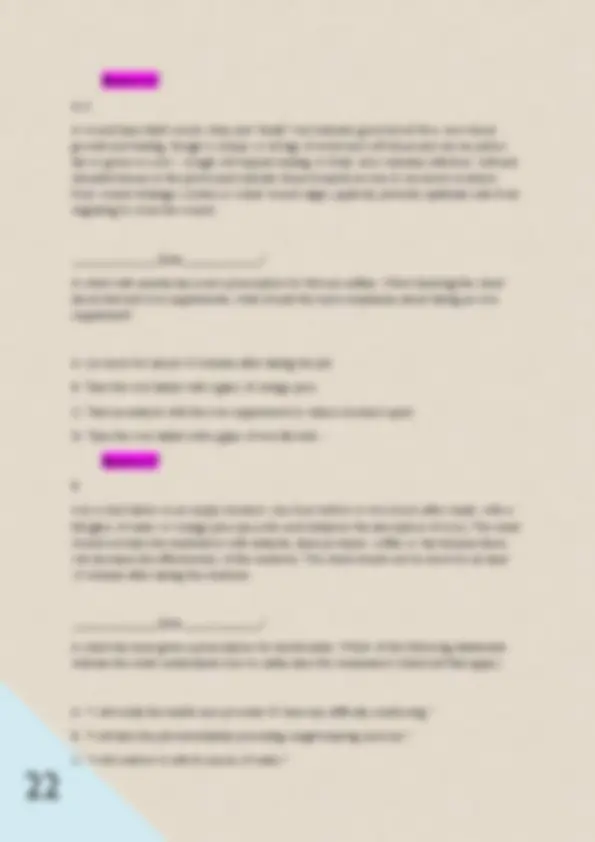
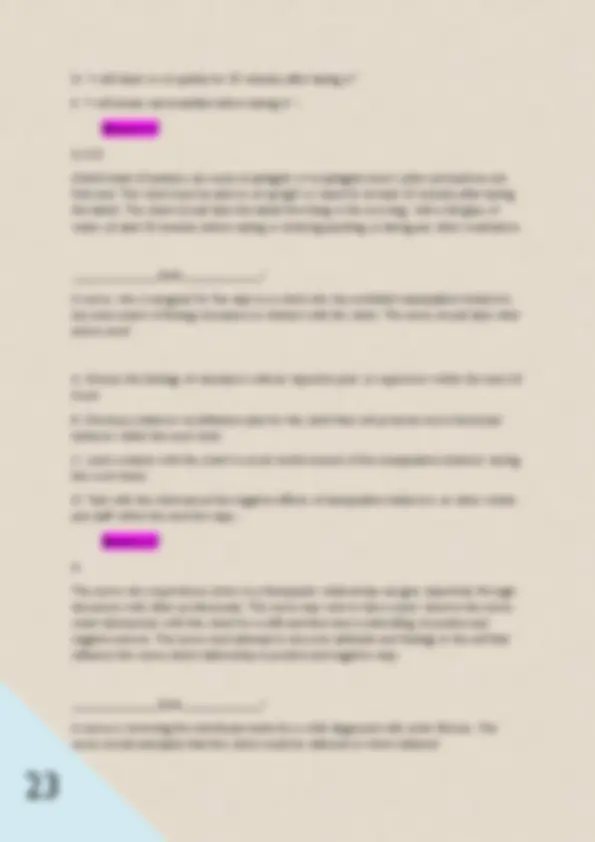
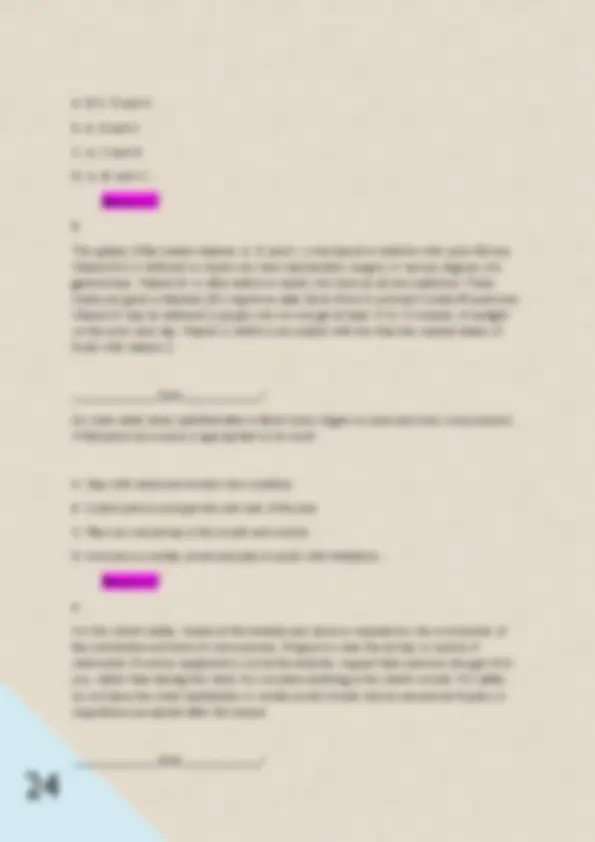
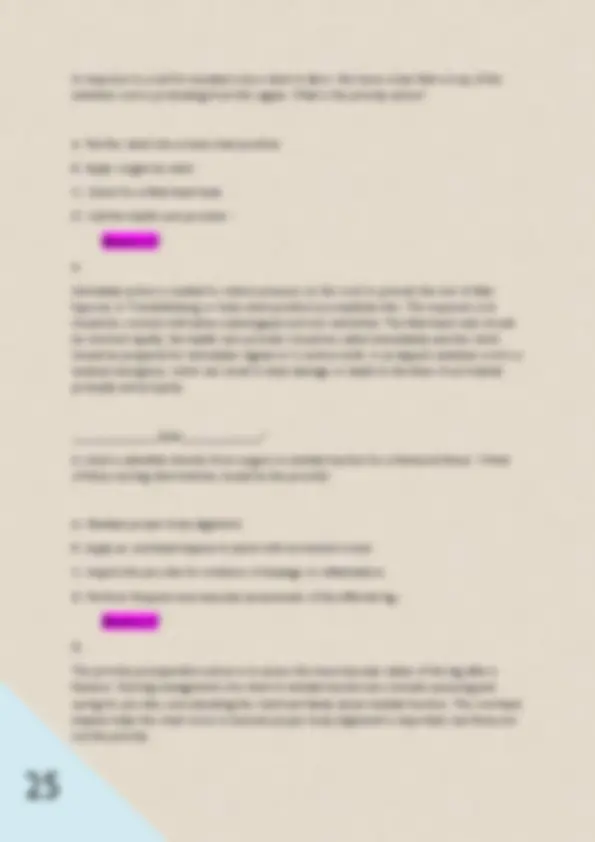
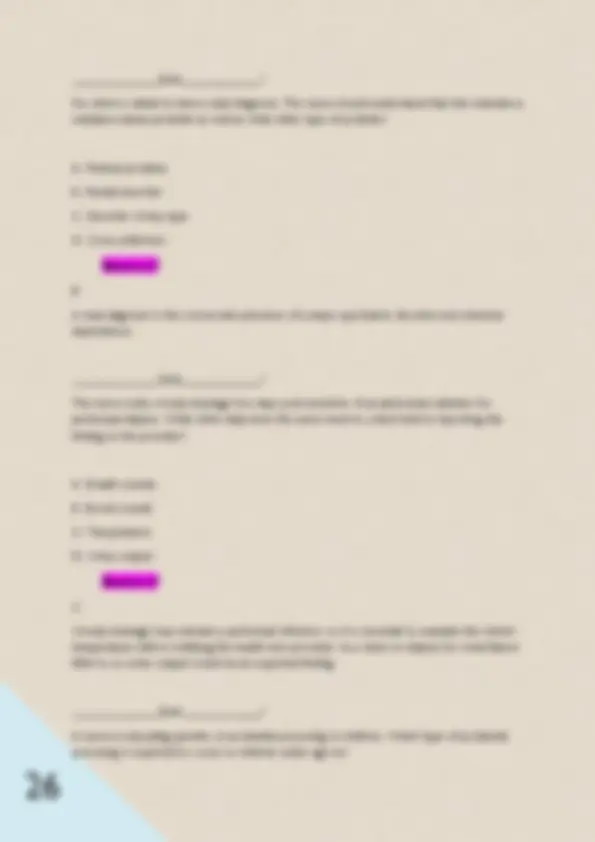
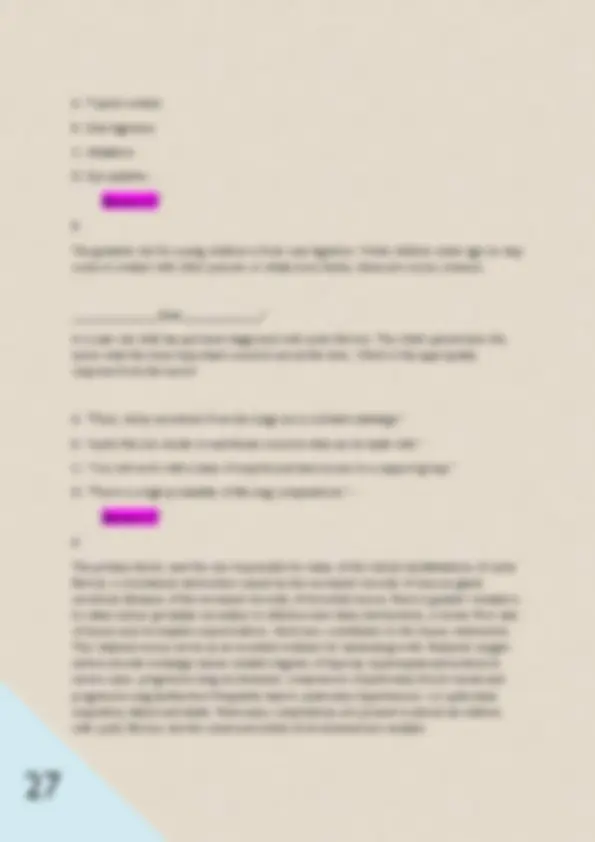
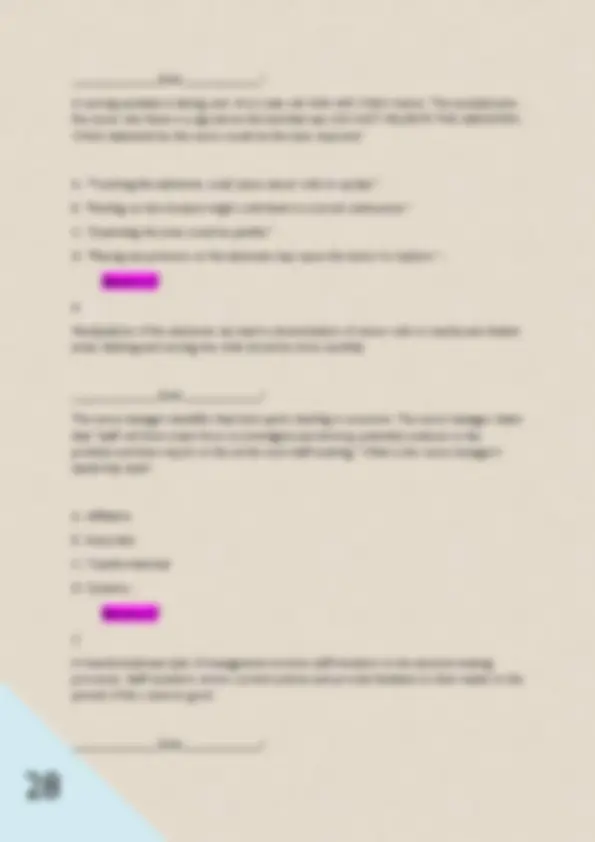
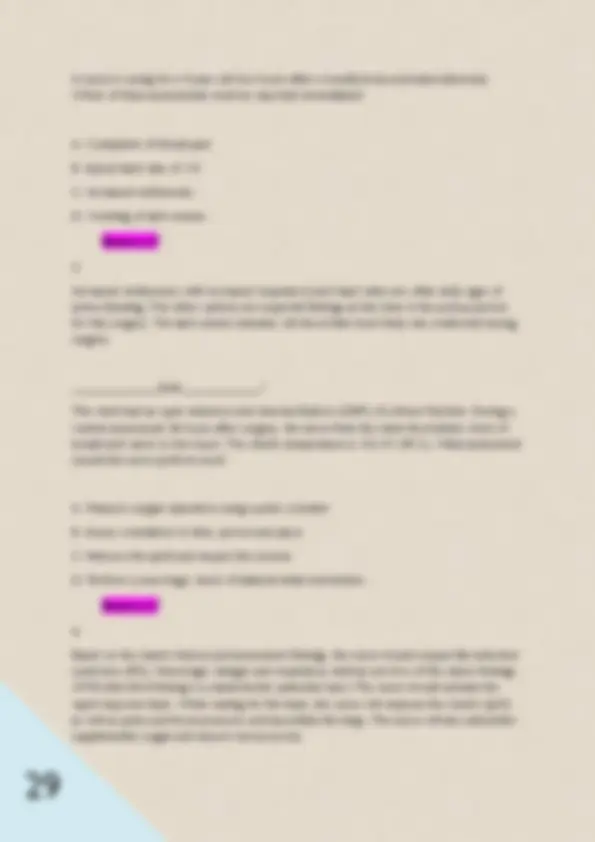
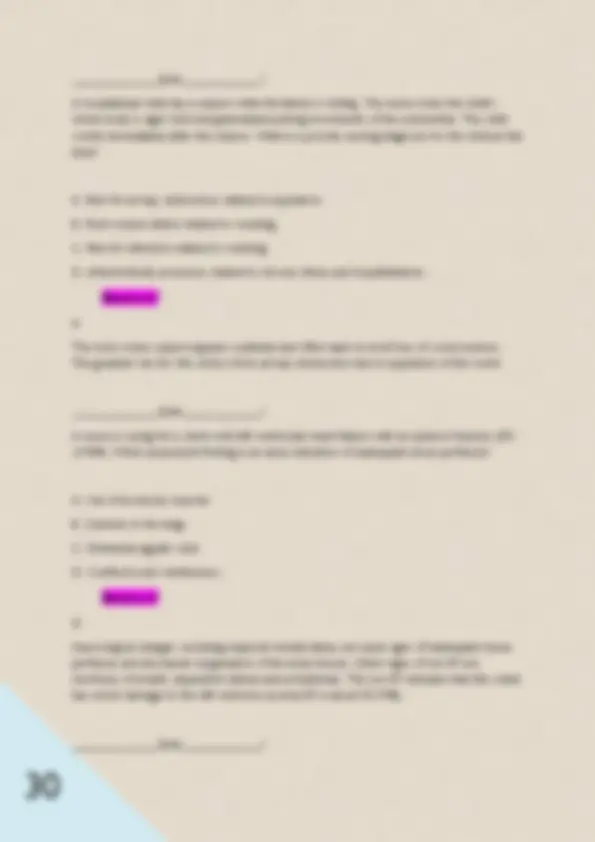
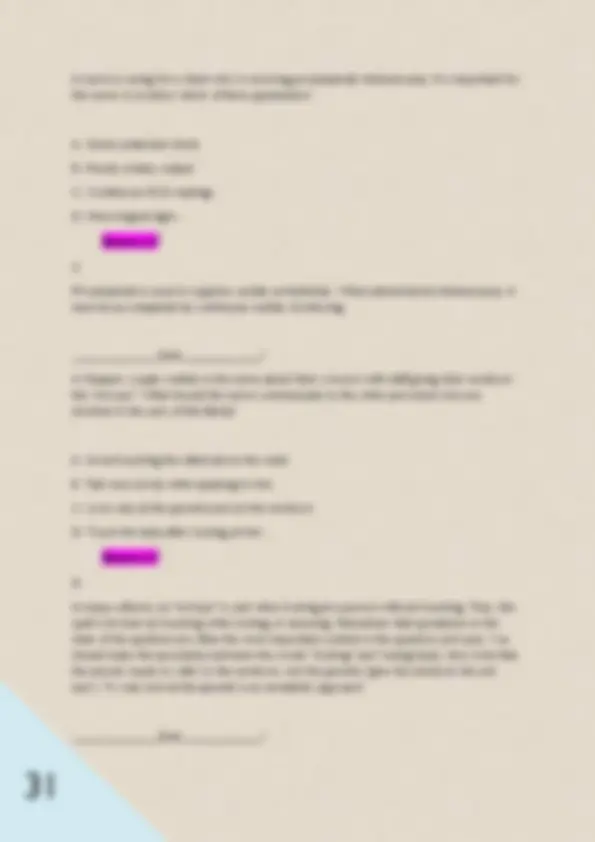
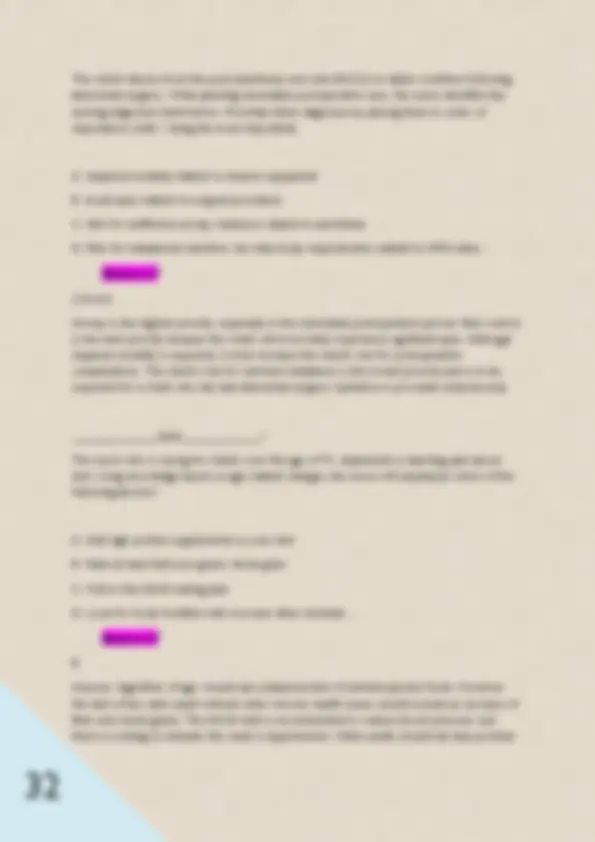
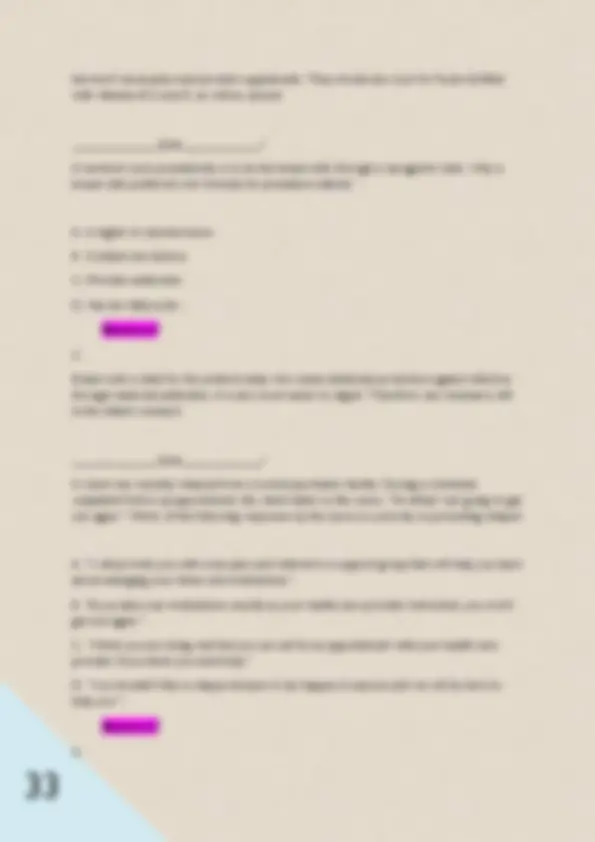
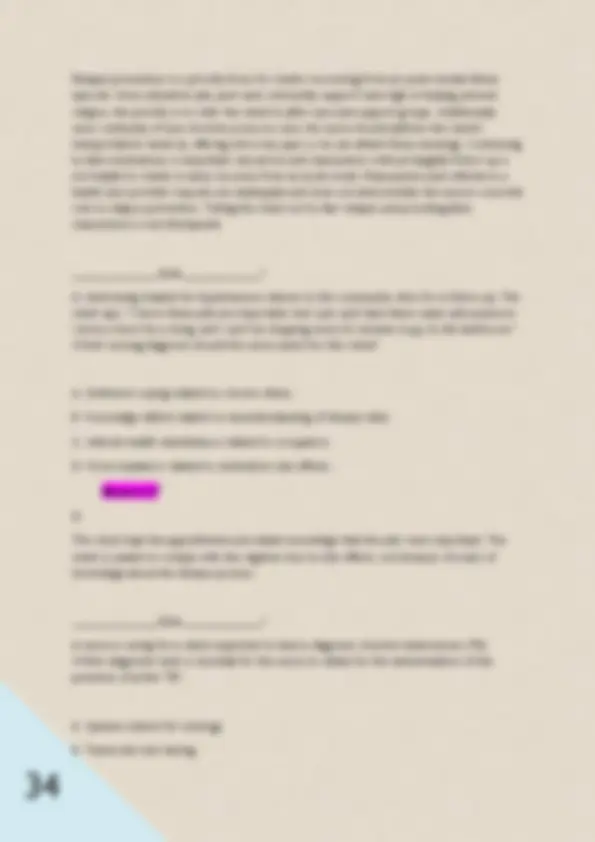
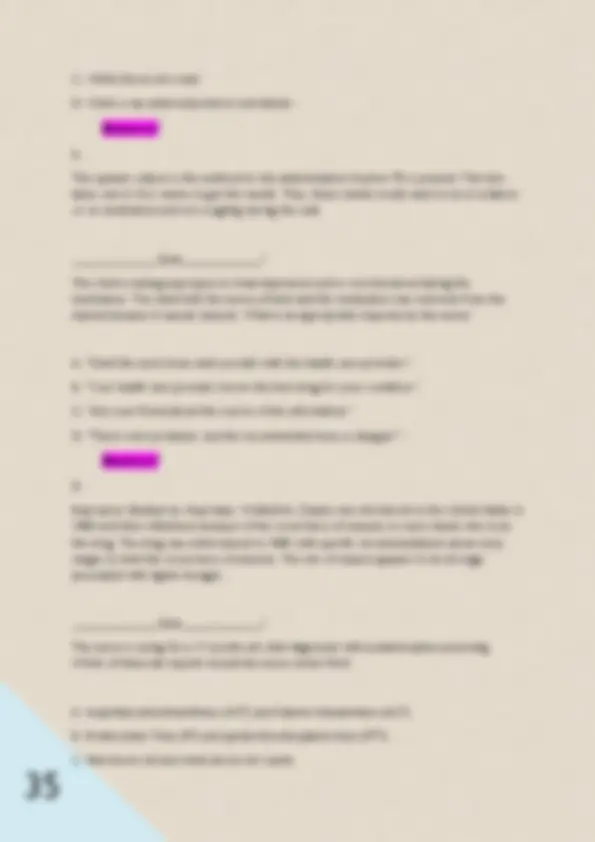
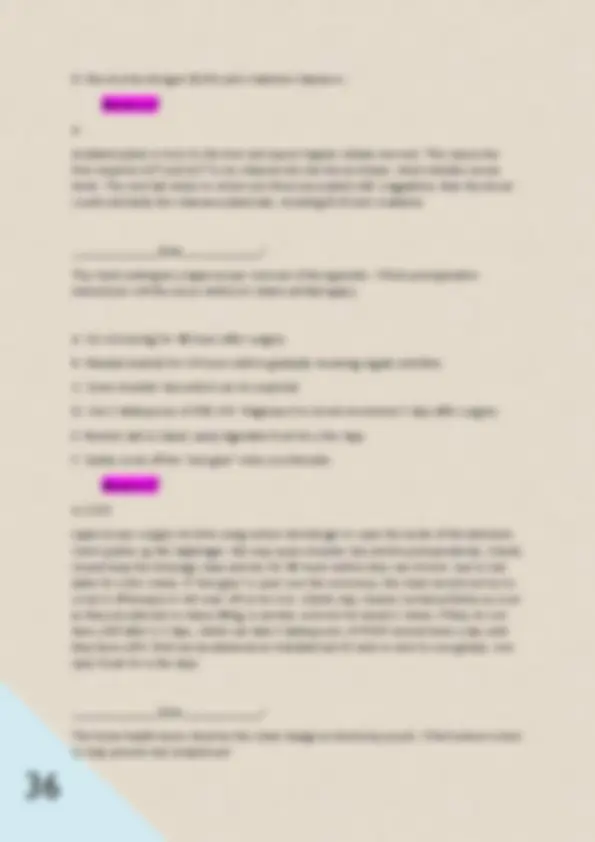
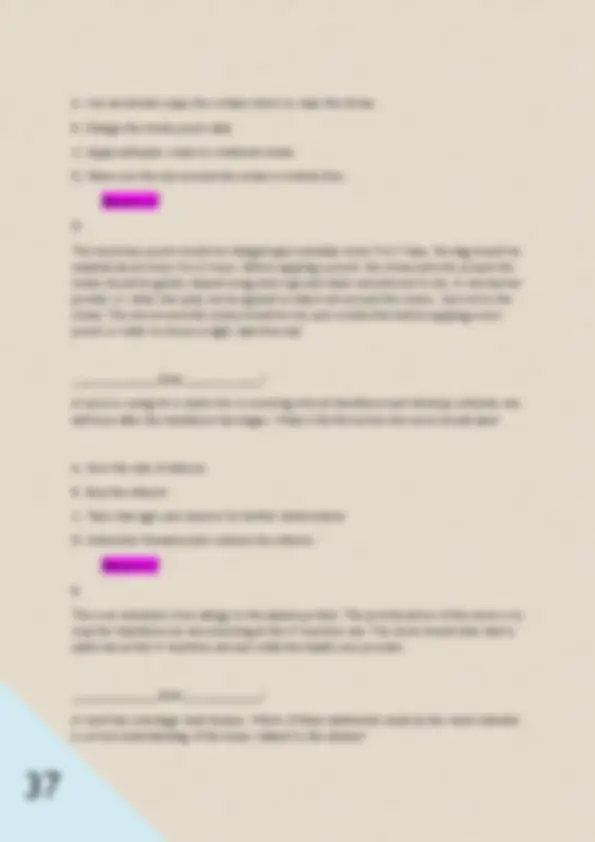
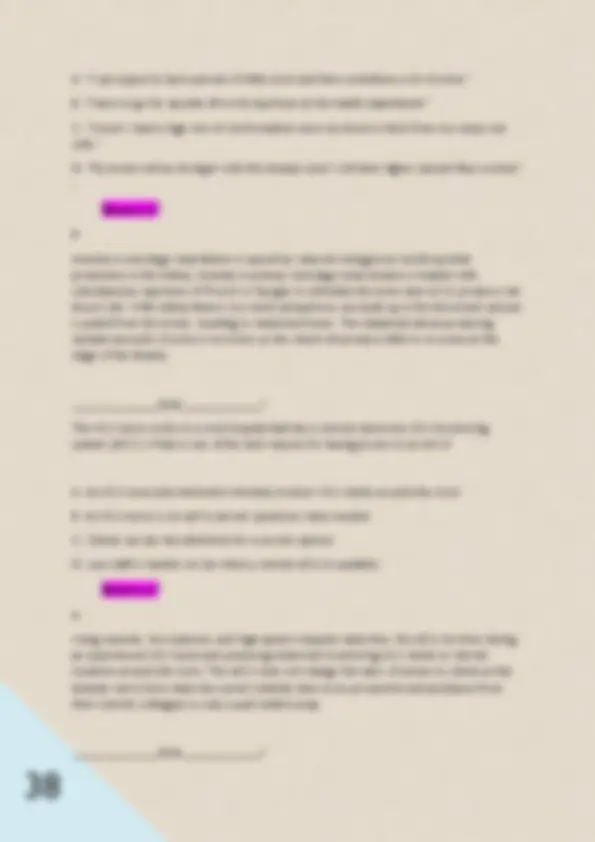
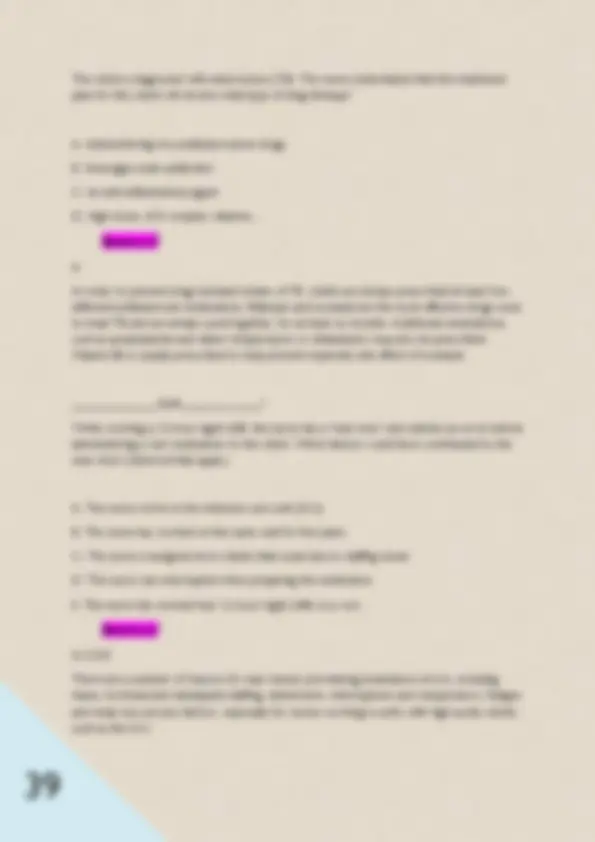
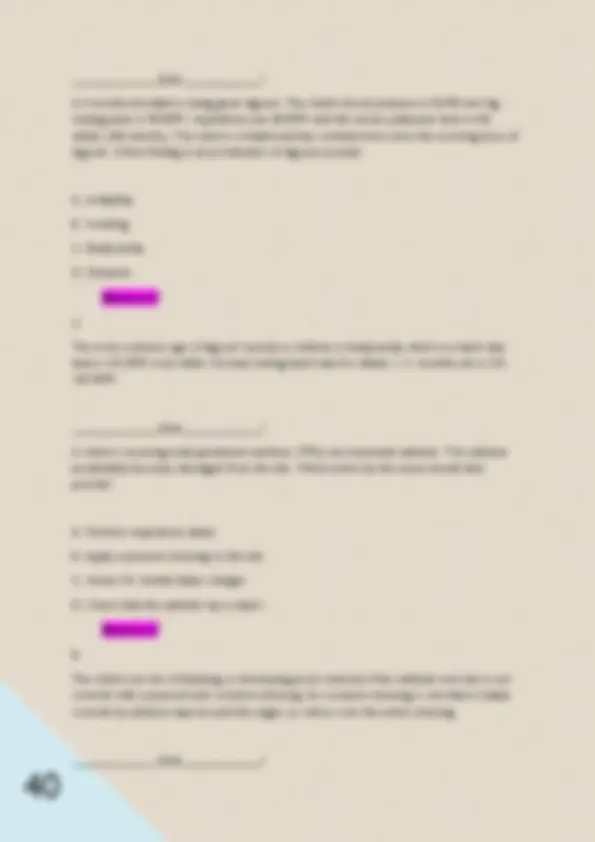
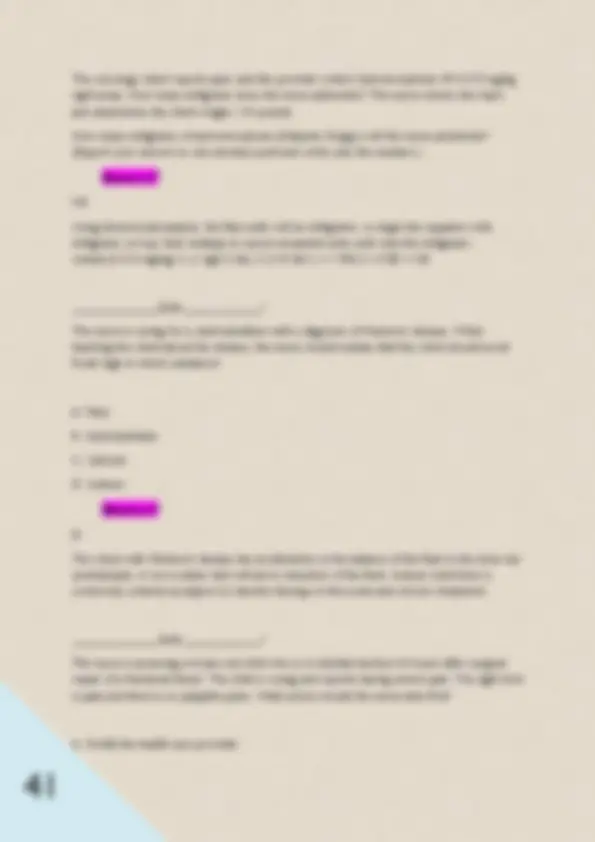
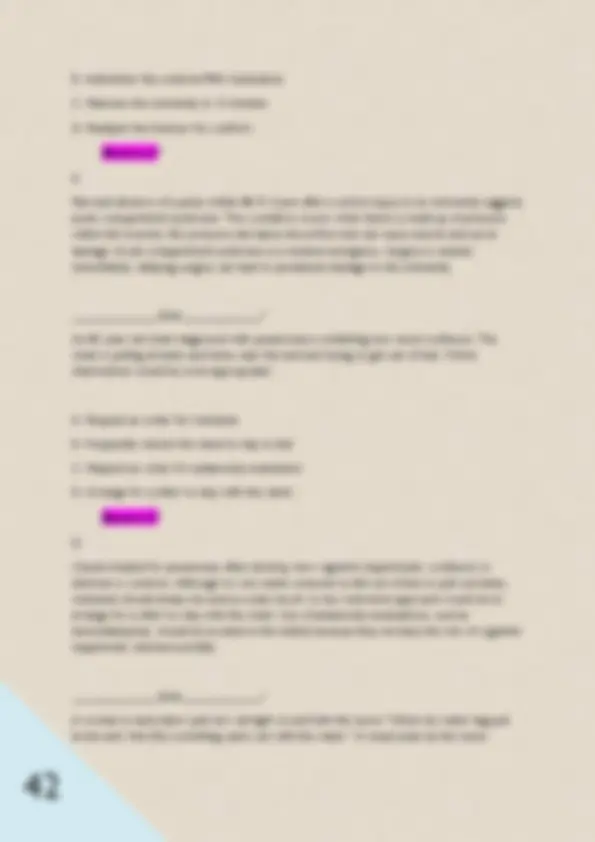
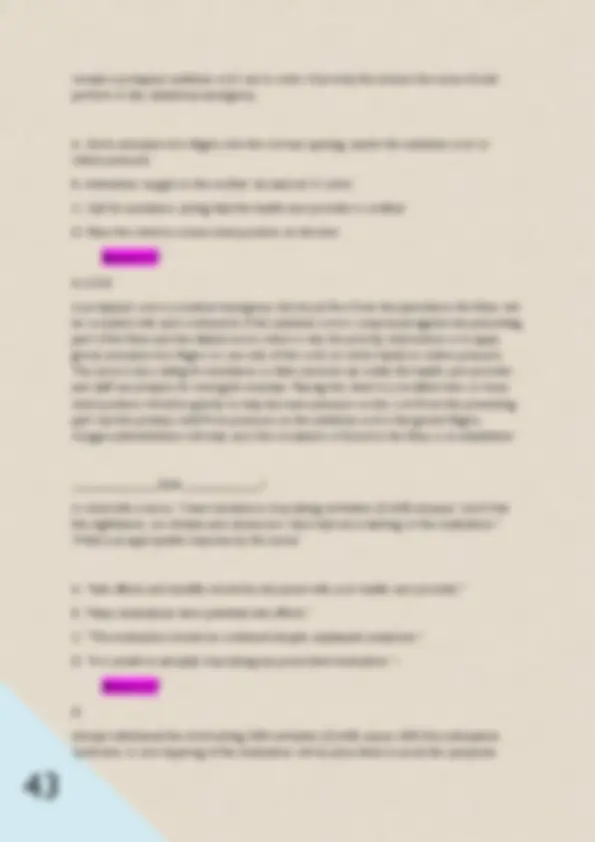
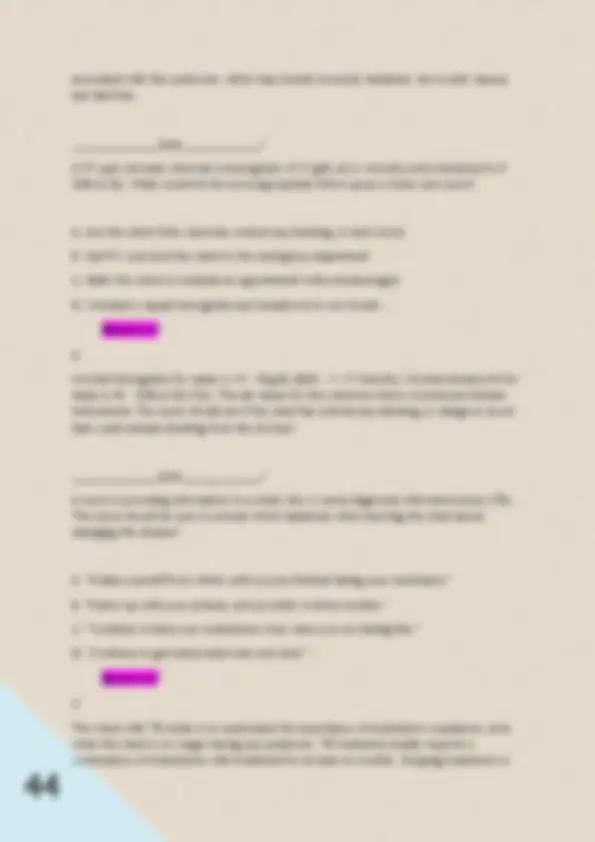
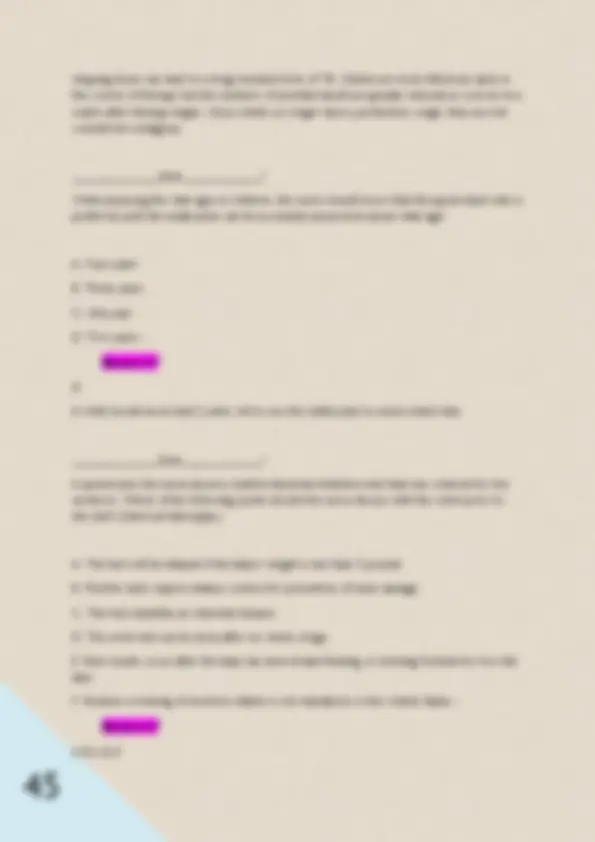
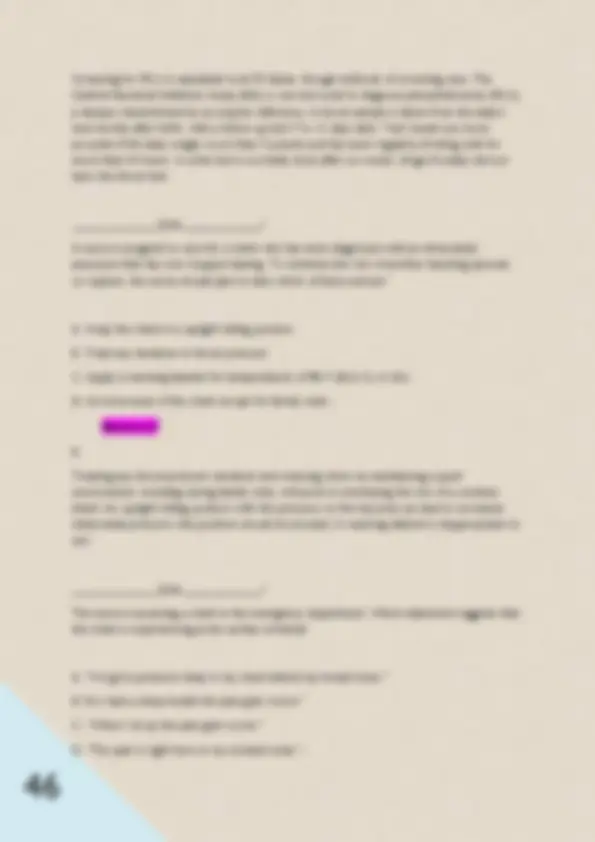
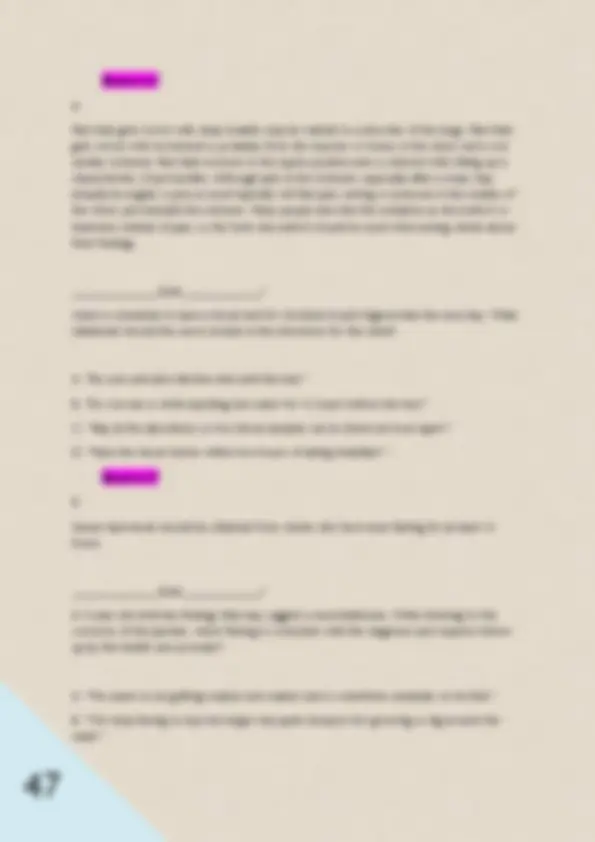
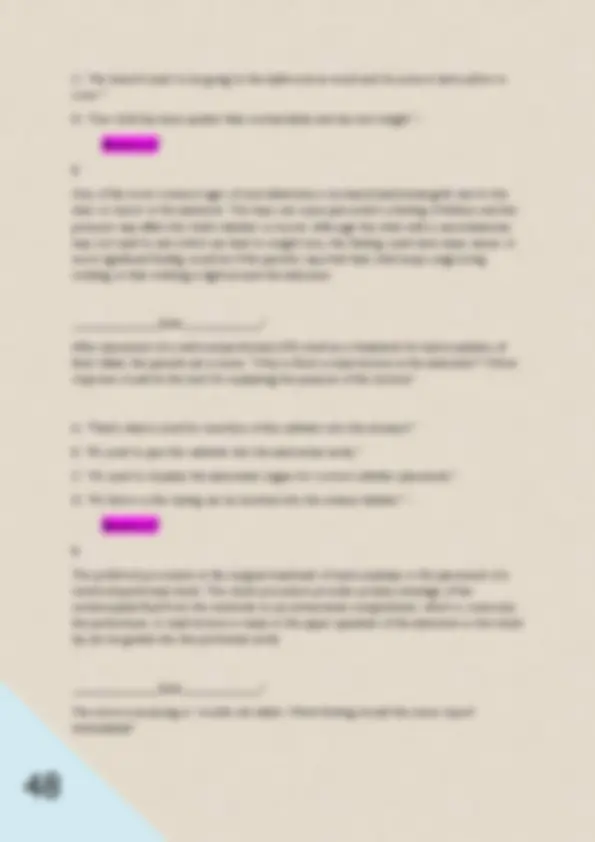
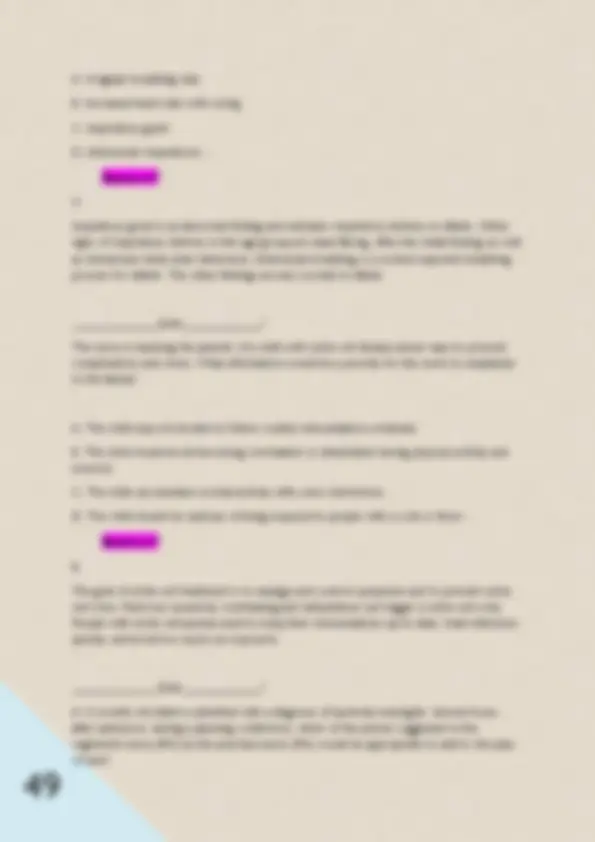
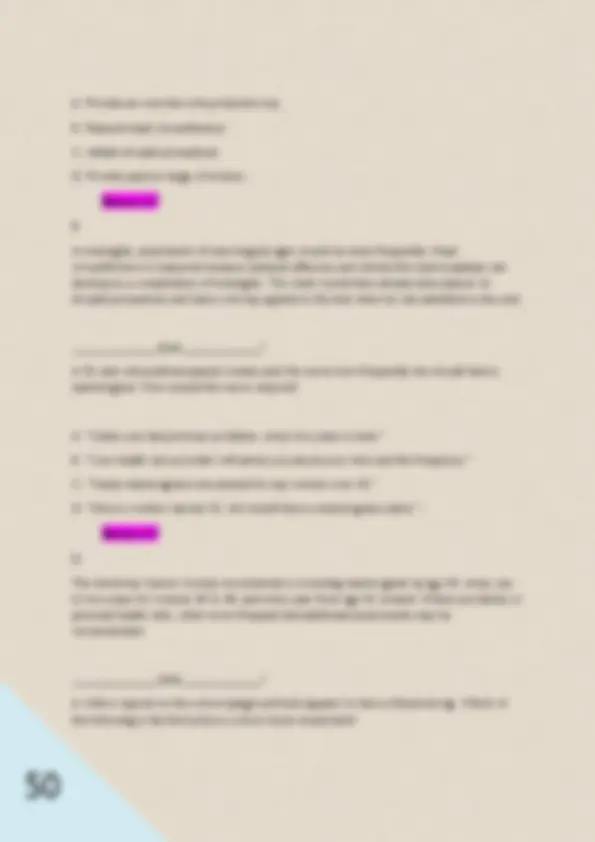
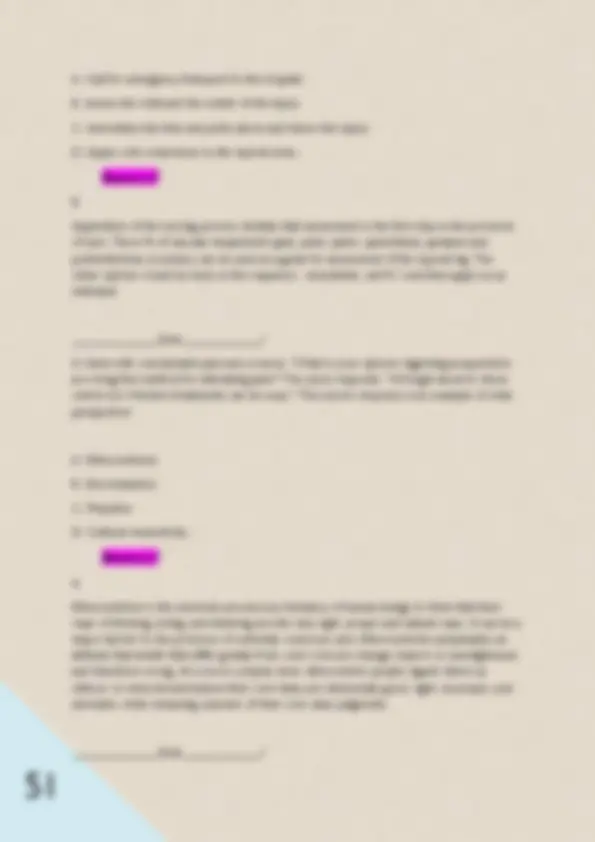
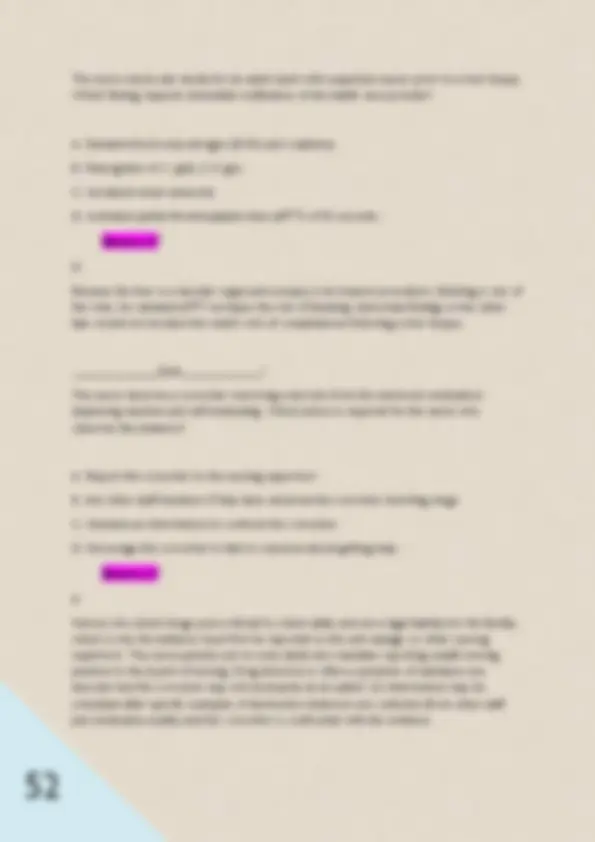
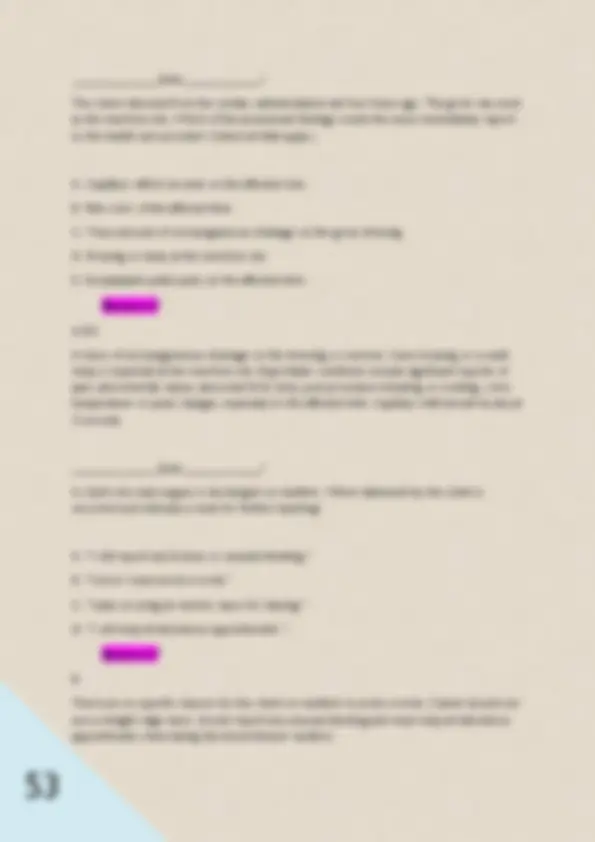
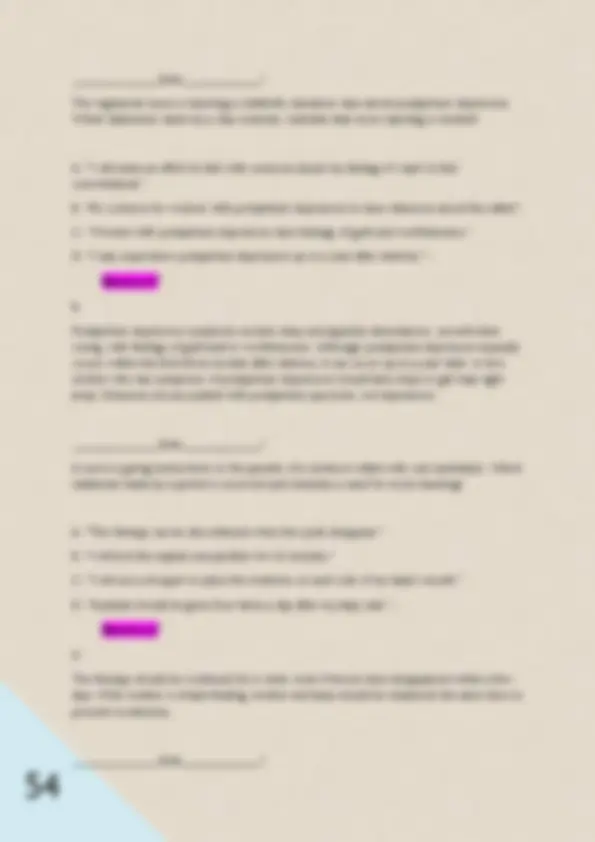
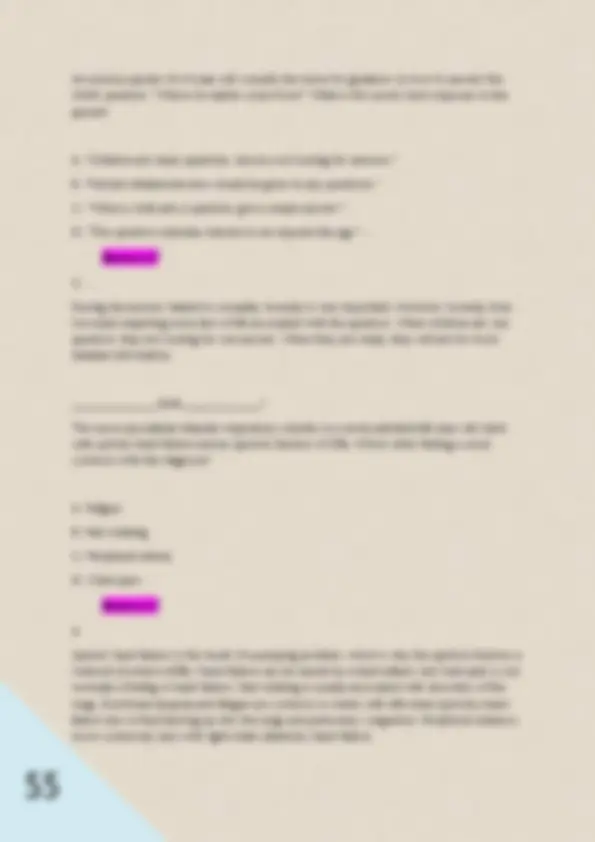
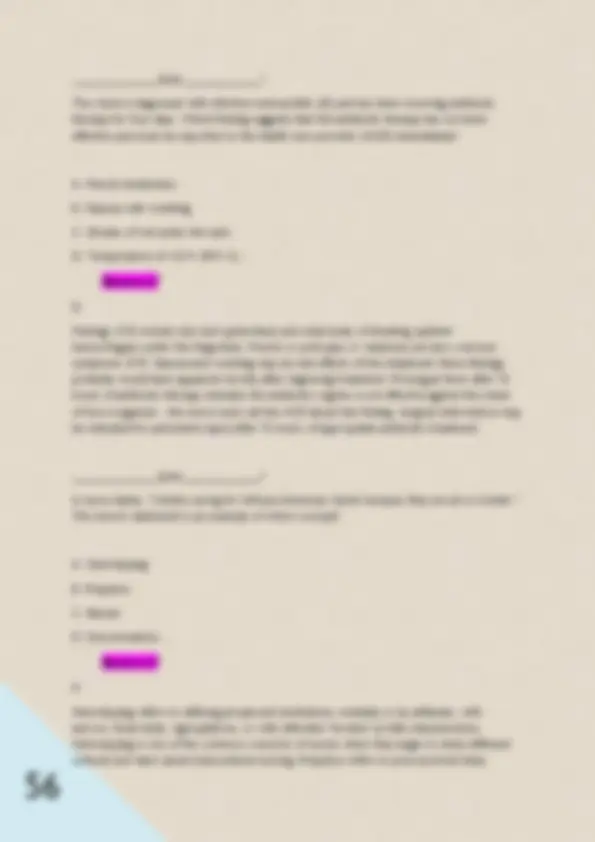
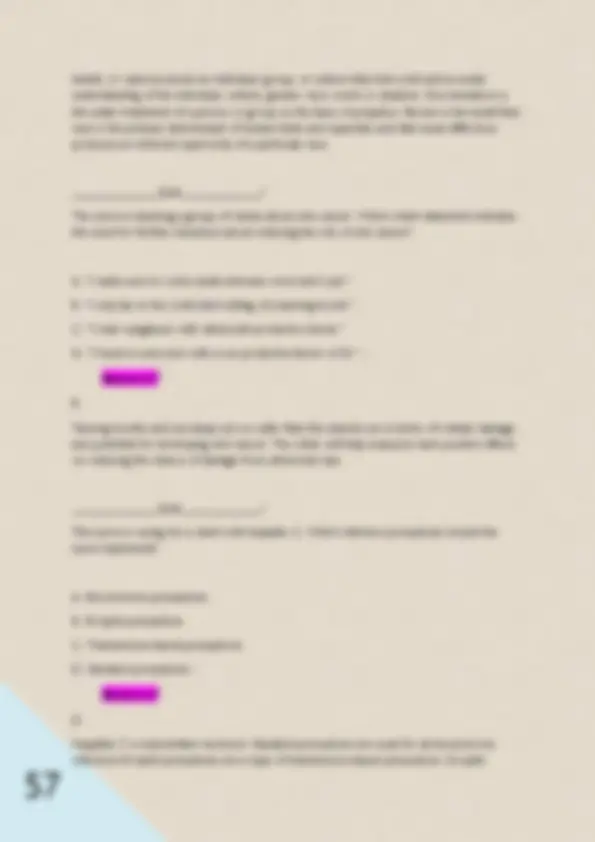
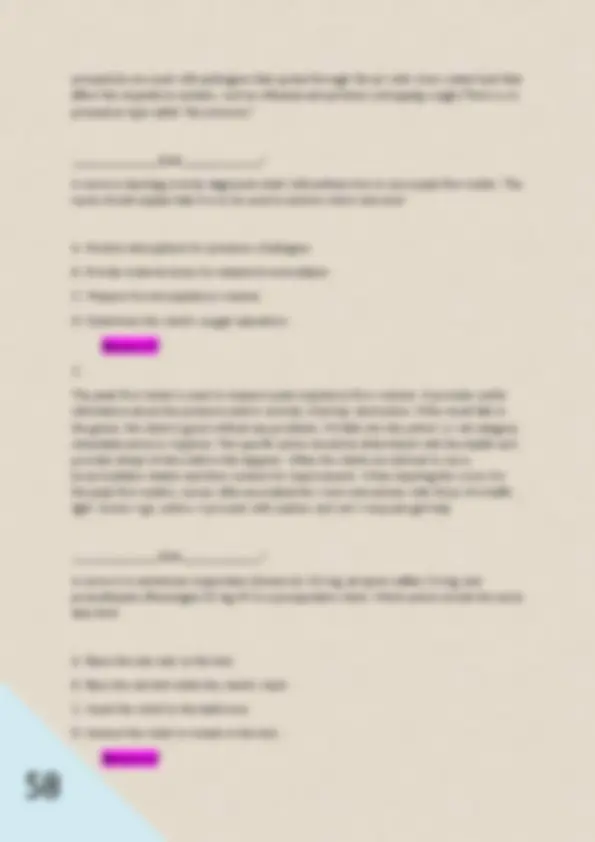
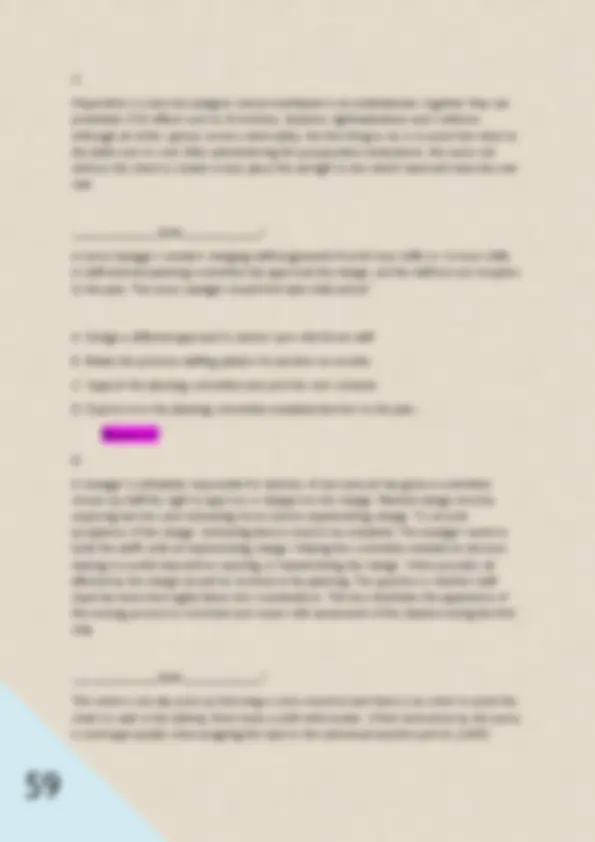
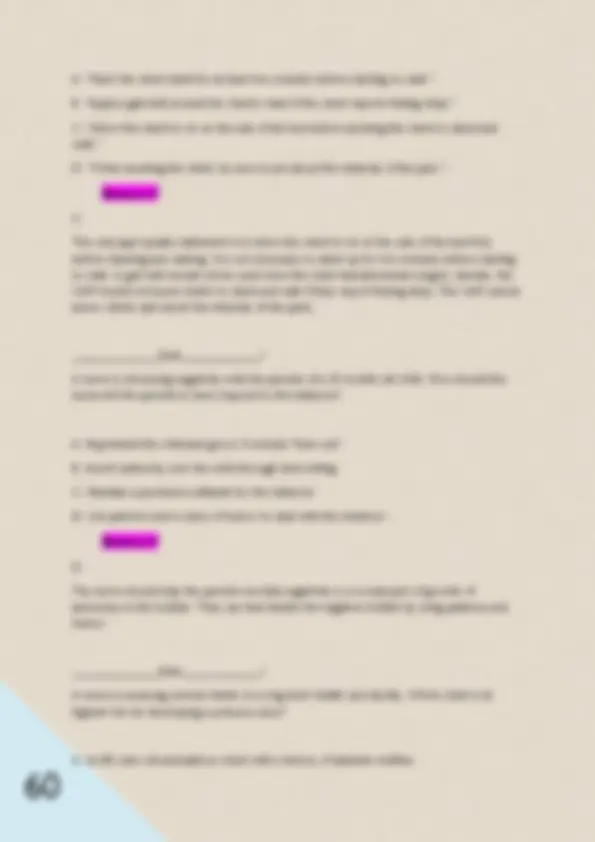
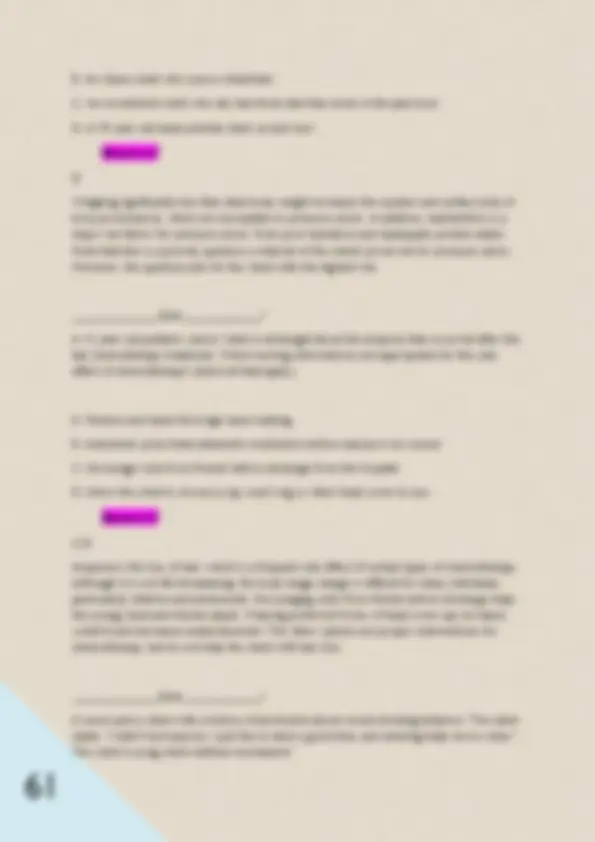
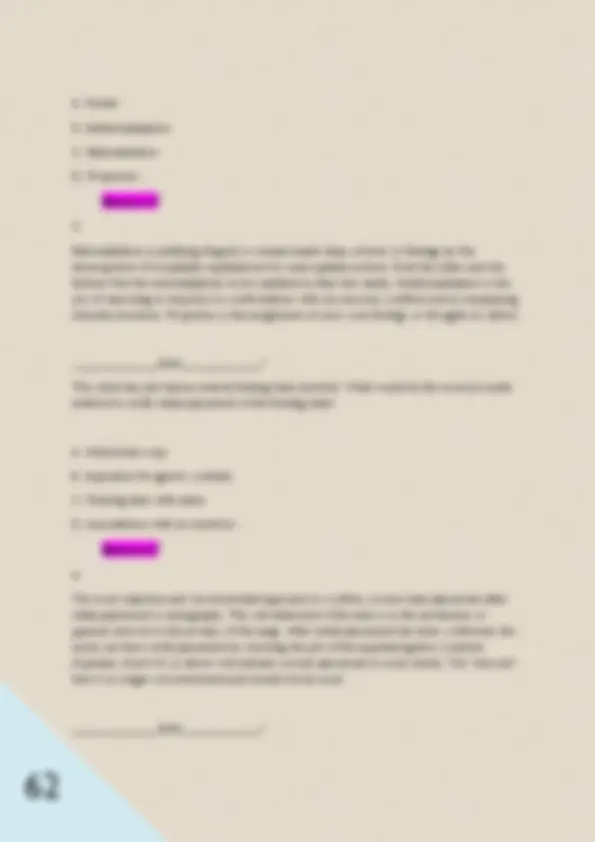
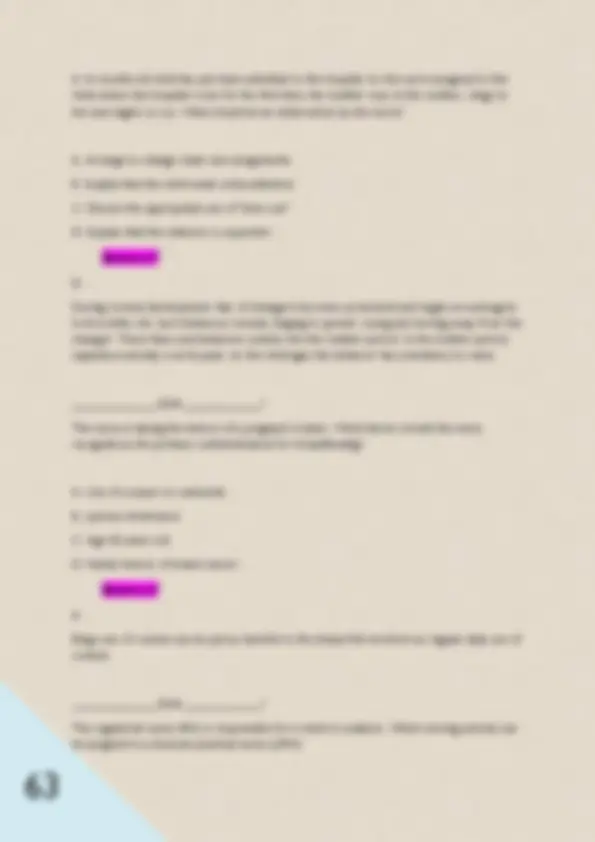
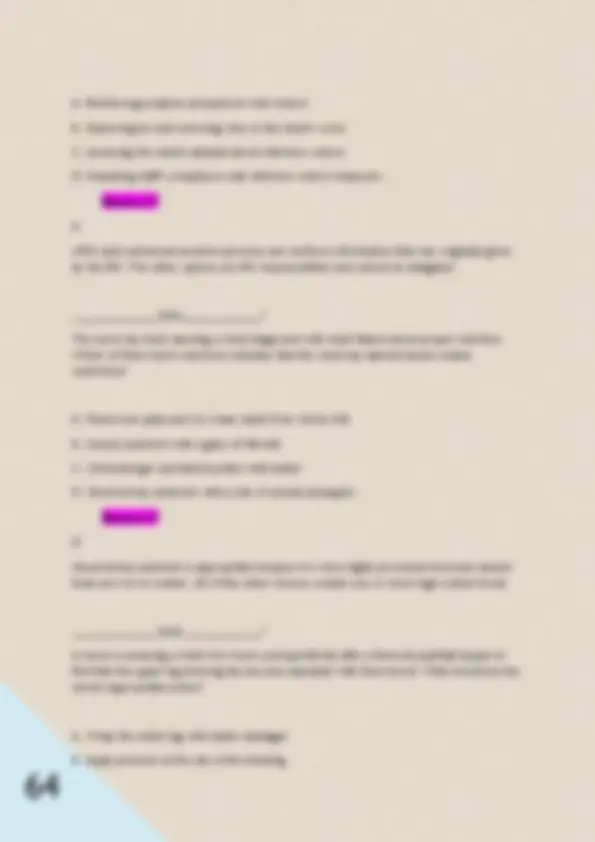
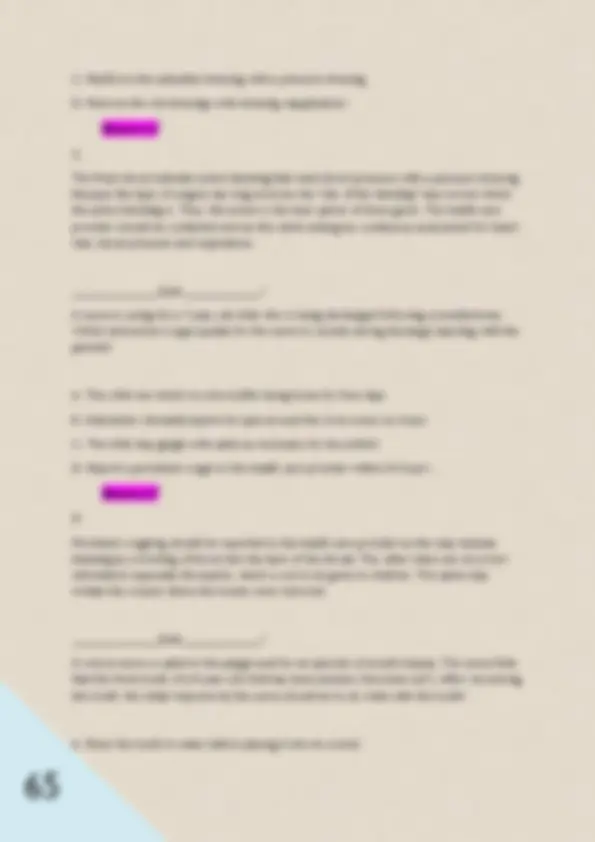
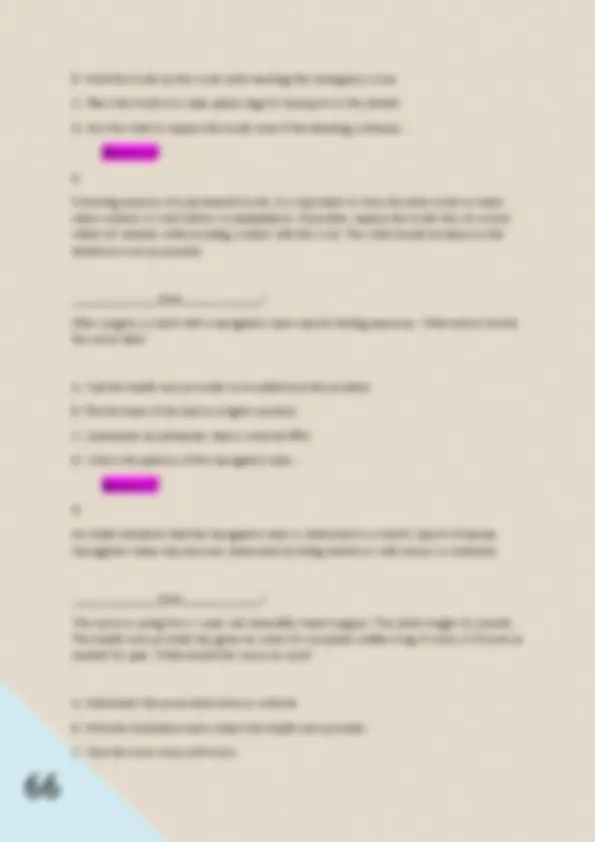

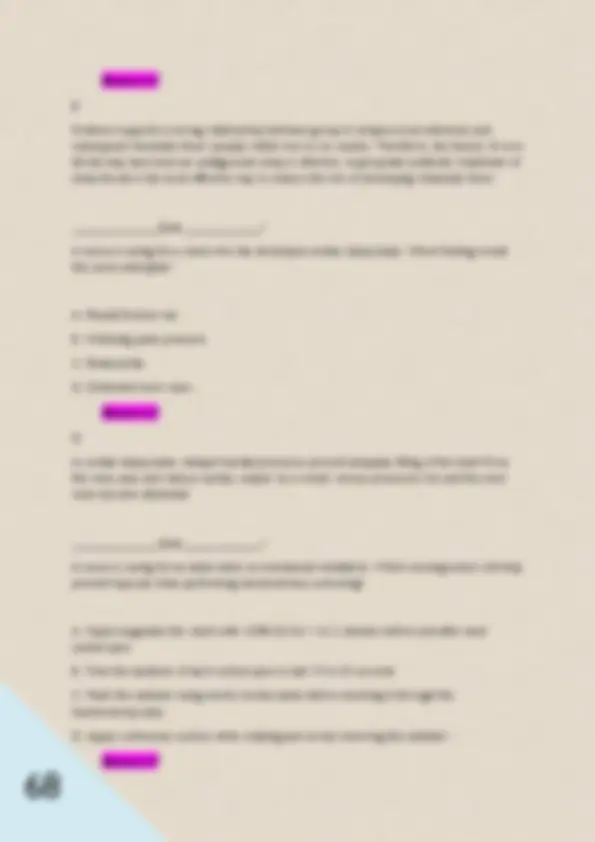
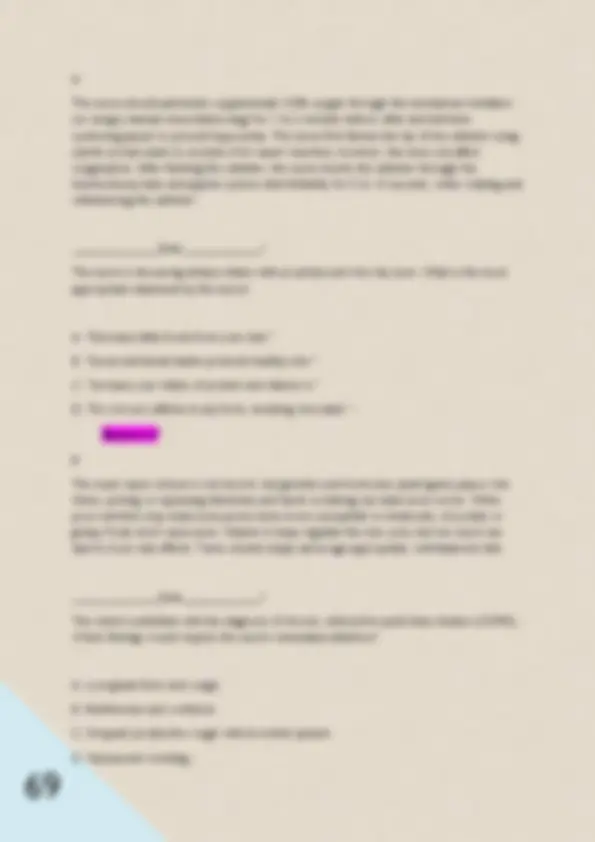
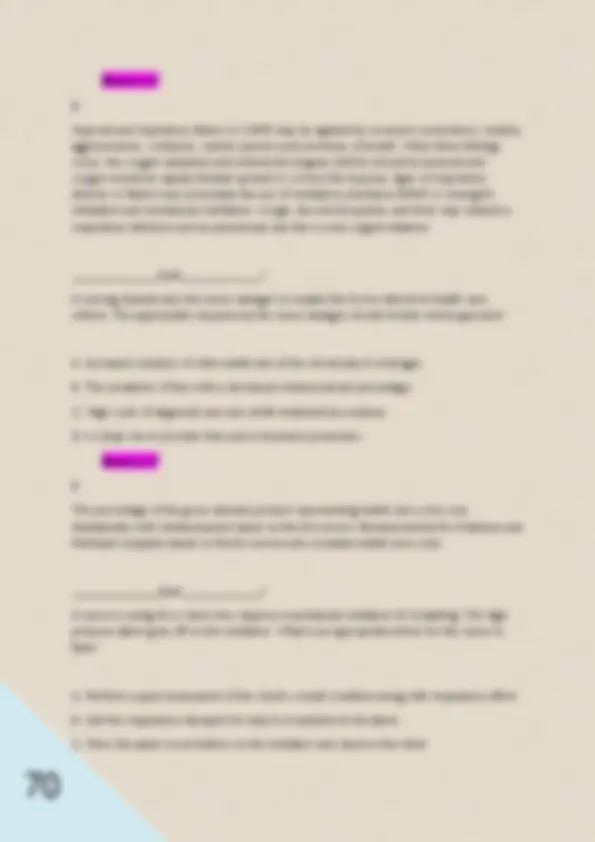
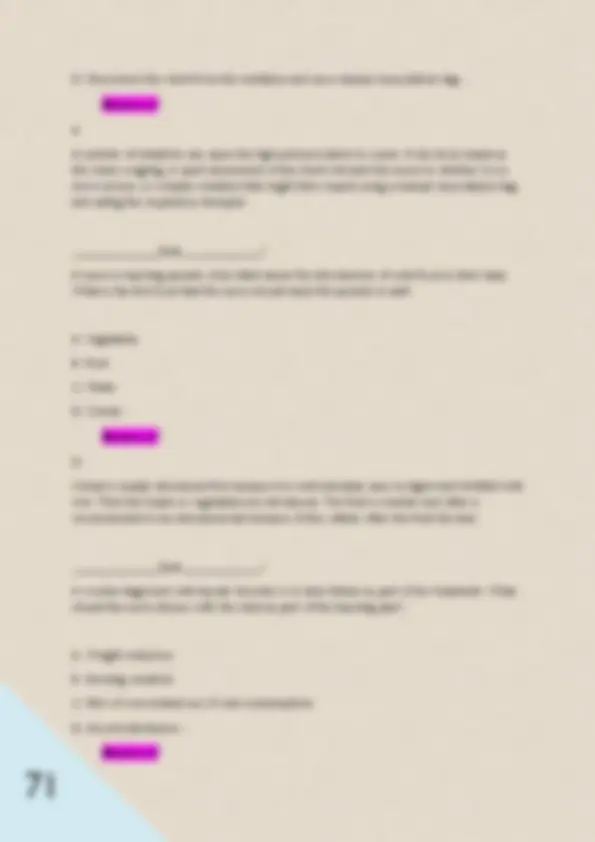
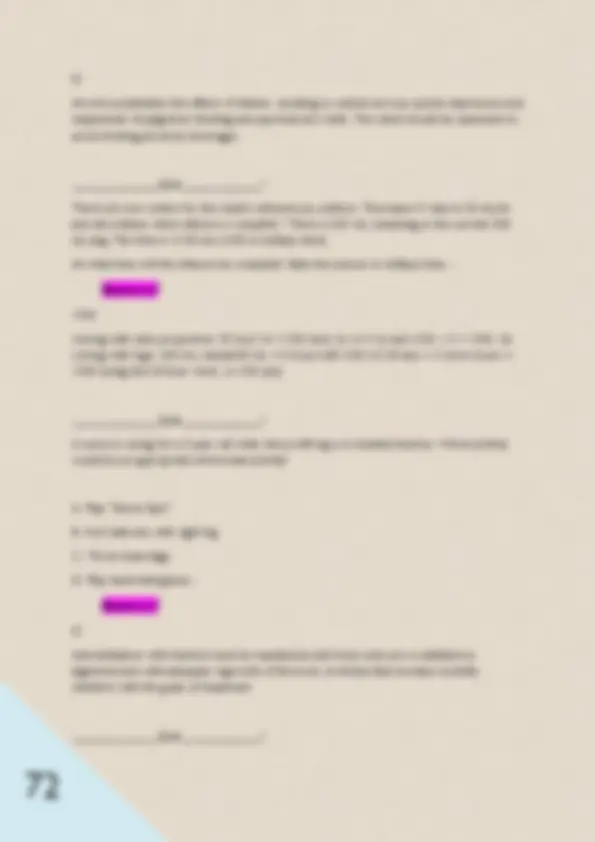
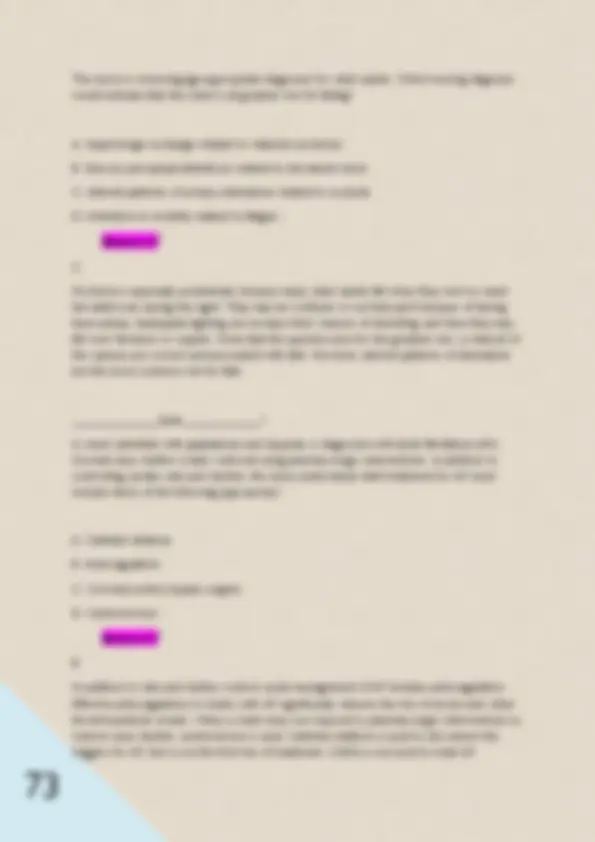
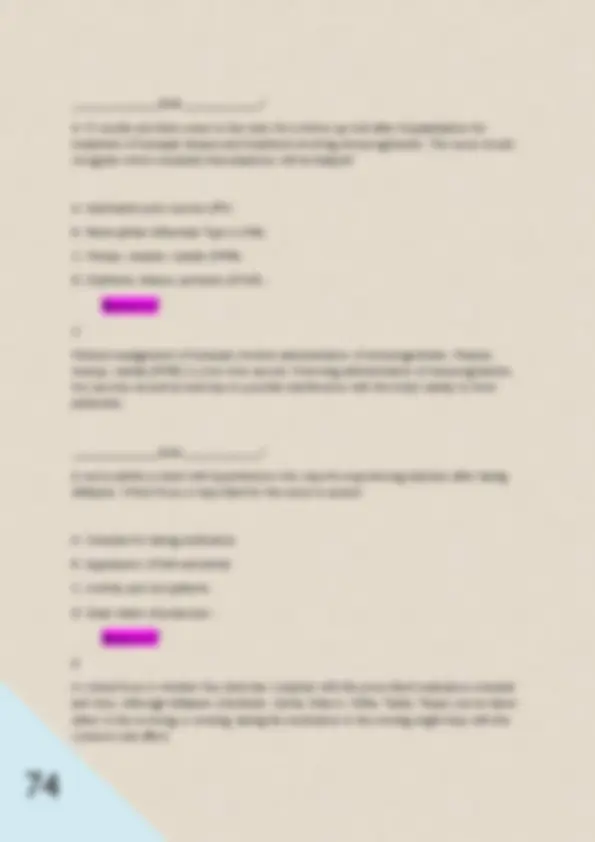
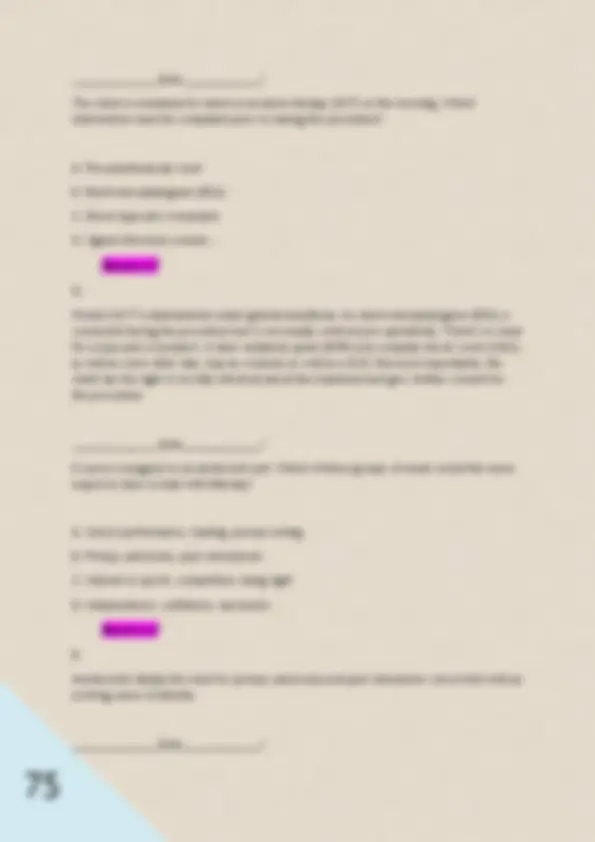
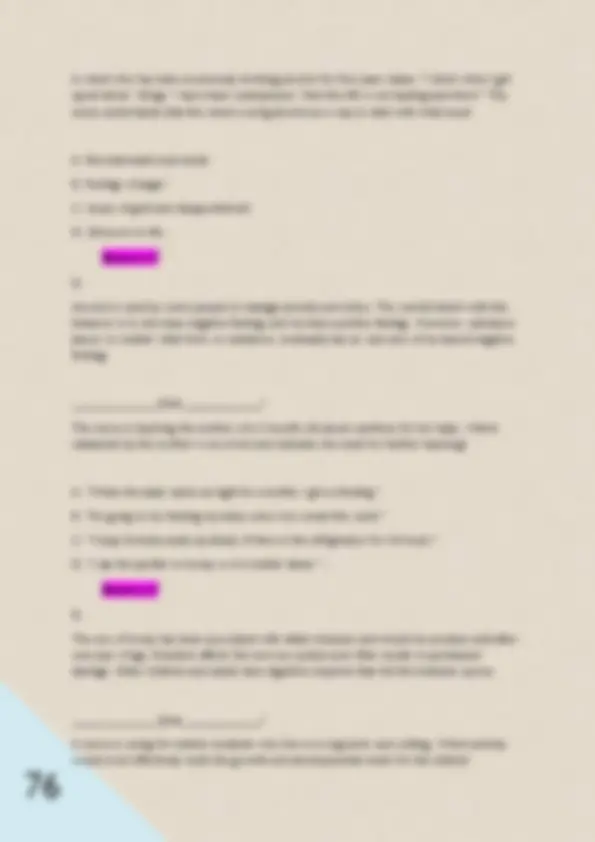
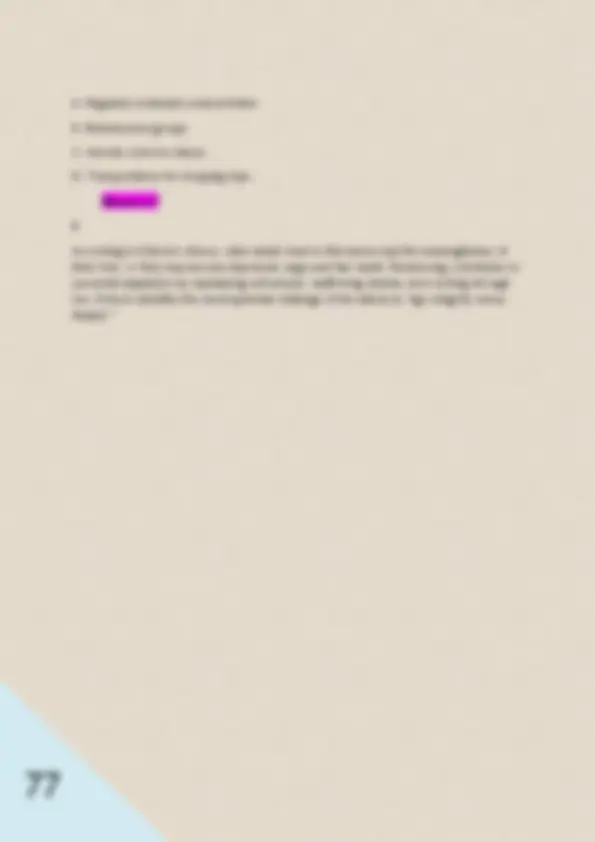


Study with the several resources on Docsity

Earn points by helping other students or get them with a premium plan


Prepare for your exams
Study with the several resources on Docsity

Earn points to download
Earn points by helping other students or get them with a premium plan
Community
Ask the community for help and clear up your study doubts
Discover the best universities in your country according to Docsity users
Free resources
Download our free guides on studying techniques, anxiety management strategies, and thesis advice from Docsity tutors
NCSBN Practice Questions 76-90 / Complete Study Guide / Actual Exam Questions & Correct Answers (Verified Detailed Answers) A Grade _____________Quiz____________? An 18 month-old weighing 22 pounds is admitted to the pediatric unit with a diagnosis of dehydration. A replacement bolus of normal saline at 20 mL/kg is ordered to be administered intravenously over 40 minutes. In mL/hour, what will be the setting for the IV delivery system? - Answer✓✓ 300 Using ratio proportion:First, convert 22 pounds to kilograms (22/2.2) = 10 kg20 mL/kg = 20 x 10 kg = 200 mL200 mL/40 minutes = x mL/60 minutes (in an hour)200 x 60 = 12000/40 = 300 mL/hrUsing dimensional analysis:20 mL/kg x 1 kg/2.2 lb x 22 lb x 60 min/hr x 1/40 min = 300 mL/hr _____________Quiz____________? The mother of a 2 month-old baby calls a pediatrician's nurse two days after the first DTaP, inactivated polio vaccine (IPV), Hepatitis B and Haemophilus influenzae type B (HIB) immunizations. She reports that
Typology: Exams
1 / 77

This page cannot be seen from the preview
Don't miss anything!






































































_____________Quiz____________? An 18 month-old weighing 22 pounds is admitted to the pediatric unit with a diagnosis of dehydration. A replacement bolus of normal saline at 20 mL/kg is ordered to be administered intravenously over 40 minutes. In mL/hour, what will be the setting for the IV delivery system? -
Using ratio proportion:First, convert 22 pounds to kilograms (22/2.2) = 10 kg20 mL/kg = 20 x 10 kg = 200 mL200 mL/40 minutes = x mL/60 minutes (in an hour)200 x 60 = 12000/40 = 300 mL/hrUsing dimensional analysis:20 mL/kg x 1 kg/2.2 lb x 22 lb x 60 min/hr x 1/40 min = 300 mL/hr _____________Quiz____________? The mother of a 2 month-old baby calls a pediatrician's nurse two days after the first DTaP, inactivated polio vaccine (IPV), Hepatitis B and Haemophilus influenzae type B (HIB) immunizations. She reports that the baby feels very warm, cries inconsolably for as long as three hours, and has had several shaking spells. Which immunization would the nurse expect to be primarily responsible with these findings? A. DTaP B. IPV
C. Hepatitis B D. HIB -
DTaP immunization is a vaccine that protects against diptheria, tetanus and pertussis (whooping cough). The majority of reactions described in this question occur with the administration of the DTaP vaccination. Contraindications to giving repeat DTaP immunizations include the occurrence of severe side effects after a previous dose, as well as signs of encephalopathy within seven days of the immunization. _____________Quiz____________? A client diagnosed with angina has been instructed about the use of sublingual nitroglycerin. Which statement made by the client is incorrect and indicates a need for further teaching? A. "I'll call the health care provider if pain continues after three tablets five minutes apart." B. "I will rest briefly right after taking one tablet." C. "I understand that the medication should be kept in the dark bottle." D. "I can swallow two or three tablets at once if I have severe pain." -
Clients must understand that just one sublingual tablet should be taken at a time and placed under the tongue. After rest and a five-minute interval, a second and then eventually a third tablet may be necessary. _____________Quiz____________? The nurse is working with victims of domestic abuse. The nurse should understand which of these factors is a reason why domestic violence or emotional abuse remains extensively undetected? A. The expenses due to police and court costs are prohibitive B. Little knowledge is known about batterers and battering relationships C. There are typically many series of minor, vague complaints
B. "No, your presence may cause the client to become more anxious." C. "No, it would be best if you brought the client some reading material that the client could read at night." D. "Yes, would you like to spend the night when the client's behavior indicates that the client is or will be frightened?" -
Encouragement of a family member or a close friend to stay with the client in a quiet surrounding cannot only help increase orientation, but can also minimize confusion and anxiety. The visitor could also report to the nurse any unusual findings of the client. This would be the most supportive approach for this client. _____________Quiz____________? The RN, who is functioning as the charge nurse, needs to determine shift assignments. How will the charge nurse determine which client assignments are appropriate for the licensed practical nurse (LPN)? A. Ask the LPN about prior experience caring for clients with similar diagnoses B. Determine how many nursing assistants are available to help the LPN with client care C. Refer to the list of technical tasks LPNs are trained to perform D. Review the procedure manual with the LPN prior to making an assignment -
The definition of assignment is the routine care, activities and procedures that are within the authorized scope of practice of the RN or LPN/LVN. The RN must determine the needs of the clients and make assignments not only based on scope of practice, but also education, demonstrated competency and skill level. Regardless if the LPN received education and training to perform specific skills, the RN needs to determine the LPN's experience with caring for clients with similar diagnoses. While the RN is responsible for ensuring an assignment given to a delegatee is carried out completely and correctly, the LPN must be able to perform the skills or tasks independently. _____________Quiz____________?
The nurse is caring for a school-aged child with a diagnosis of secondary hyperparathyroidism after treatment for chronic renal disease. Which serum lab data should receive priority attention by the nurse? A. Osmolality and sodium B. Blood urea nitrogen and magnesium C. Calcium and phosphorus D. Glucose and potassium -
The parathyroid regulates the calcium and phosphorus serum levels. Calcium and phosphorous levels will be elevated in hyperfunction of this gland until the client is stabilized. To recall this information think of a see-saw. Associate that calcium is first in the alphabet and thus calcium follows the direction of the abnormality - hyper or hypo function - of the parathyroid. Put the calcium on one side and the phosphorus on the other side of the see- saw. _____________Quiz____________? The nurse is caring for a client who just had a central venous catheter line inserted at the bedside. Which of these assessments requires immediate attention by the nurse? A. Pallor in the extremities B. Increased temperature by one degree C. Involuntary coughing spells D. Dyspnea at rest -
Complications of central catheter insertion include pneumothorax and hemothorax. Air embolism is another potential complication. Dyspnea, shallow respirations, sudden sharp chest pain that worsens with coughing or deep breathing are indications of pneumothorax. Other potential complications of central catheters may include thrombosis, local or systemic infection, or even cardiac tamponade (if the central line perforates the heart).
When dealing with a medical emergency, the rule is to assess airway first, then breathing, and then circulation. Starting oxygen is the priority. The other actions should also be implemented as quickly as possible, including activation of the rapid response team. The client is experiencing an acute episode of fulminant pulmonary edema, likely as a result of a new and severe cardiac event and possible cardiogenic shock. Emergency assessment and intervention is indicated to prevent cardiac arrest and possible death. _____________Quiz____________? There is an order for a continuous lidocaine infusion at a rate of 4 mg/minute to treat PVCs. The IV solution contains 2 grams of lidocaine in 500 mL of D5W. The infusion pump delivers 60 microdrops/mL. What rate in microdrops/minute would deliver 4 mg of lidocaine/minute? Report the response using a whole number. -
Dimensional analysis (DA): Remember in DA, you always want to start your equation with what's called for in the solution. In this case, you want to know microdrops/minute.microdrops/minute = 4 mg/min X 1 g/1000 mg X 500 mL/2 g X 60 microdrops/mL = 4 X 500 X 60/1000 X 2 = 120000/2000 = 60 microdrops/mLAnother way to solve for X:What you have: 2 grams (2000 mg) lidocaine in 500 mL AND you are using a microdrip set (60 microdrops/mL)What you want/need: 4 mg lidocaine to infuse/minute mg/min X 500 mL/2000 mg X 60 (microdrops)/min = 60 microdrops/minute _____________Quiz____________? The nurse is reviewing client assignments at the beginning of the shift. Which task could be safely assigned to an unlicensed assistive person (UAP)? A. Stay with a client during the self-administration of insulin B. Clean and apply a dressing to a small pressure ulcer on the leg C. Empty a client's colostomy bag D. Monitor a client's response to passive range of motion exercises -
If the UAP has demonstrated competency in the task, s/he may empty a client's colostomy bag. This is an uncomplicated, routine task with an expected outcome. The other tasks involve one or more parts of the nursing process and cannot be assigned to an UAP. _____________Quiz____________? The school nurse is screening the children for scoliosis. At what time of development should the nurse expect to see early findings of scoliosis? A. During the years when children begin to run and jump B. During a preadolescent growth spurt C. In early infancy before 8 months of age D. When a child begins to play competitive sports -
Idiopathic scoliosis is seldom apparent before 10 years of age and is most noticeable at the beginning of the preadolescent growth spurt. It is more common in females than in males. _____________Quiz____________? The home care nurse is admitting a new client with a diagnosis of COPD, atrial fibrillation and gout. After reviewing the client's medication list, the nurse would arrange for periodic monitoring of blood drug levels for which of the following medications? (Select all that apply.) A. Beclomethasone inhaled (Qvar) B. Digoxin (Lanoxin) C. Theophylline (Elixophyllin, Theo-24, Uniphyl) D. Allopurinol (Aloprim, Zyloprim) E. Glipizide (Glucotrol) -
_____________Quiz____________? A client asks the nurse about including her 2 year-old and 12 year-old sons in the care of their newborn sister. Which response is an appropriate initial statement by the nurse? A. "Focus on your sons' needs during the first days at home." B. "Suggest that your partner spend more time with the boys." C. "Tell each child what he can do to help with the baby." D. "Ask the children what they would like to do for the newborn." -
In an expanded family, it is important for parents to reassure older children that they are loved and as important as the newborn. _____________Quiz____________? The nurse is caring for a client who is exhibiting a panic attack. What should the nurse do for this client? A. Assist the client to describe the experience in detail B. Develop a trusting relationship C. Maintain safety for the client D. Teach the client to control behaviors -
Clients who display signs of severe anxiety in the form of a panic attack need to be supervised closely until the anxiety is lessened. They may harm themselves or others because during panic attacks perception is narrowed and thinking is flawed. _____________Quiz____________?
The nurse is to review the topic of caring for clients with Guillain-Barré syndrome with other staff members at a monthly meeting. Which of these findings should the nurse include in the discussion? (Select all that apply.) A. Weakness, tingling or loss of sensation in legs and feet occur first B. Rapidly progressive ascending paralysis of the legs, arms, respiratory muscles and face C. Difficulty with bladder control or intestinal functions D. Hypertension E. Difficulty with eye movement, facial movement, speaking, chewing or swallowing F. Numbness, tingling, prickling sensation or moderate pain throughout the body -
Guillian-Barré is an autoimmune disease. The symptoms of weakness or tingling sensation begins in the legs and progresses to the arms and upper body, resulting in almost complete paralysis. The client is often put on a ventilator during the worst part of the disease to assist breathing. The client may have low blood pressure or poor blood pressure control. _____________Quiz____________? A 1 year-old child is receiving temporary total parental nutrition (TPN) through a central venous line. This is the first day of TPN therapy. Although all of the following nursing actions must be included in the plan of care of this child, which one would be a priority at this time? A. Use aseptic technique during dressing changes B. Check results of liver enzyme tests C. Maintain central line catheter integrity D. Monitor serum glucose levels -
Hyperglycemia may occur during the first day or two as the child adapts to the high-glucose load of the TPN solution. Thus, a priority nursing responsibility is blood glucose testing.
Upon completion of the admission documents, the nurse identifies that an elderly client does not have an advance directive. What action should the nurse take? A. Document this information on the chart B. Refer this issue to the nurse manager and the risk manager C. Give the client written information about advance directives D. Assume that the client wishes full resuscitation efforts -
For each admission, nurses should request a copy of a client's current advance directive. If there is none, the nurse must provide written information about what an advance directive implies. It is then the client's choice to sign the forms. Note that a standard is for non-direct care providers to witness these forms; a social worker or other health care professional would need to witness a client's signature. _____________Quiz____________? The clinic nurse is examining a 15 month-old child with suspected otitis media. Which group of findings should the nurse anticipate? A. Vomiting, pulling at ears and pearly white tympanic membrane B. Periorbital edema, absent light reflex and translucent tympanic membrane C. Diarrhea, retracted tympanic membrane and enlarged parotid gland D. Irritability, rhinorrhea, and bulging tympanic membrane -
Clinical manifestations of otitis media include irritability, rhinorrhea, bulging tympanic membrane, and pulling at the ears. _____________Quiz____________? The client is diagnosed with a large spontaneous pneumothorax and will have a chest tube inserted. The nurse understands that the chest tube is needed for which of the reasons listed below?
A. Increase intrathoracic pressure to allow both lungs to expand equally B. Drain the purulent drainage from the empyema that caused the problem C. Prevent an accumulation of blood and other drainage into the pleural cavity D. Drain air from the pleural cavity and restore normal intrathoracic pressure -
There are no clinical signs or symptoms in primary spontaneous pneumothorax until a cyst or small sac (bleb) ruptures. When air enters the pleural space, the pressure in the space equals the pressure outside the body; the vacuum is lost and the lung collapses. This causes acute onset chest pain and shortness of breath. A small pneumothorax without underlying lung disease may resolve on its own. A larger pneumothorax requires aspiration of the free air and/or placement of a chest tube to evacuate the air. _____________Quiz____________? A nurse practicing in a maternity setting has a client whose fetus is post-mature. The nurse recognizes that the fetus is at risk due to what factor? A. Excessive fetal weight B. Low blood sugar levels C. Progressive placental insufficiency D. Depletion of subcutaneous fat -
The placenta functions less efficiently as pregnancy continues beyond 42 weeks. Immediate and long-term effects may be related to hypoxia. These newborns are typically meconium stained. _____________Quiz____________? A client is scheduled for a transesophageal echocardiogram (TEE). Prior to the procedure, which activity could be delegated to the unlicensed assistive person (UAP)?
A. Passive range of motion exercise B. Pain management C. Cold compresses to elbow D. Fluid restriction -
Management of a sickle cell crisis is directed towards supportive and symptomatic treatment. The priority of care is pain relief. In a 12 year-old child, patient-controlled analgesia promotes maximum comfort. Fluid are usually increased and range of motion exercises are avoided in the acute phase of the crisis. Cold is avoided because it constricts the vessels and may result in increased pain. _____________Quiz____________? A nurse is assessing the growth of children during their school-age years. What would the nurse expect to see during this assessment? A. Decreasing amounts of body fat and muscle mass B. Little change in body appearance from year to year C. Yearly weight gain of about 5 1/2 pounds per year D. Progressive height increase of 4 inches each year -
School-age children gain about 5 1/2 pounds each year and increase about 2 inches in height. _____________Quiz____________? The nurse is assessing a child with suspected lead poisoning. Which assessment should a nurse expect to find? A. Auditory wheezes with expiration B. Numbness and tingling in feet
C. Excessive perspiration D. A history of difficulty sleeping -
A child who has unusual neurologic complaints, such as neuropathy or footdrop that cannot be attributed to other causes, may be affected by lead poisoning. This may occur when a child ingests or inhales paint chips from lead-based paint or dust during remodeling in older buildings. Other findings of lead poisoning are appearance of bluish gum line, hyperactivity and developmental delays. _____________Quiz____________? The nurse assesses delayed gross motor development in a 3 year-old child. The inability of the child to do which action confirms this finding? A. Catch a ball B. Ride a bicycle C. Skip on alternate feet D. Stand on one foot -
At this age, gross motor development allows a child to balance on one foot. _____________Quiz____________? A client has a history of chronic obstructive pulmonary disease (COPD). The nurse enters the client's room to find that the nasal cannula is in proper position with the oxygen set at 6 liters per minute, the client's color is flushed and the respirations are 8 per minute. What should the nurse do first? A. Remove the nasal cannula for at least five minutes B. Lower the oxygen's flow rate C. Place client in a higher sitting position
A client continuously calls out to the nursing staff when anyone passes the client's door and asks them to do something in the room. The charge nurse should take which approach for this client? A. Reassure the client that a staff person will check frequently to see if the client needs anything B. Arrange for each staff member to go into the client's room to check on needs every hour on the hour C. Keep the client's room door cracked to minimize the distractions of people passing by the room D. Assign a nursing staff member to visit the client at regular intervals -
Regular, frequent, planned contact by a designated staff member is the best approach to provide a continuity of care and communicate to the client that care will be available as needed. _____________Quiz____________? A nurse working at a clinic is reviewing a client's blood sugar log and recognizes that the client is not consistently monitoring blood sugar. Which of the following diagnostic tests would assist the nurse in evaluating the client's overall management of diabetes? A. Hemoglobin B. Fasting blood sugar C. Hemoglobin A1C D. White blood cell count -
The hemoglobin A1C is the best indicator of glycemic control because it reflects an average of the blood sugar over the life of a red blood cell (approximately 90 to 120 days). The fasting blood sugar will only evaluate the client's blood sugar at that specific testing time. Hemoglobin and a white blood cell count are not used to determine blood sugar levels.
_____________Quiz____________? A client who has returned from surgery reports feeling nauseated and later has an emesis. The nurse administers promethazine per standing orders. In addition to relief from nausea, what other effects of this medication does the nurse expect? (Select all that apply.) A. Dry mouth B. Sedation C. Pinpoint pupils D. Heart palpitations E. Runny nose -
Promethazine (Phenergan) is used as an antihistamine, sedative and antiemetic. It produces anticholinergic effects, such as dry mouth and nasal congestion, dilated pupils and urinary retention. Although promethazine is a sedative, the nurse should understand that it can cause some people to have heart palpitations and to feel restless and unable to sleep. _____________Quiz____________? The nurse suspects that the client is in cardiogenic shock. Which of the following findings supports this information? A. Bradycardia B. Increased cardiac output C. Decreased or muffled heart sounds D. Bounding pulses -
Cardiogenic shock involves decreased cardiac output and evidence of tissue hypoxia in the presence of adequate intravascular volume; it is the leading cause of death in acute MI. Findings of cardiogenic shock include hypotension, rapid and faint peripheral pulses, distant- sounding heart sounds, cool and mottled skin, oliguria and altered mental status.